
SUSTAINABILITY REPORT
2014
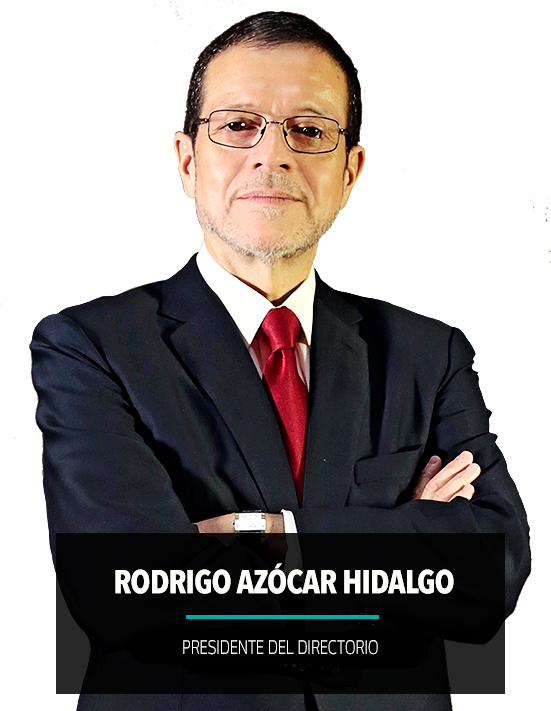
LETTER FROM THE CHAIRMAN
2014 was not just any old year for Metro. In fact, it wasn’t a good year at all.
All tallied, the company faced several complicated situations that overshadowed the progress and improvements that were implemented on behalf of our customers and Santiago residents as a whole.
There have been very few times throughout out corporate history when we have been battered by events that have had both a negative impact on public opinion and on how we are perceived by our users, as well as a profound impact on how our company operates.
Metro’s importance as a key part of the capital city’s mass transit system and its impact on the lives of more than 2.4 million riders who use our service daily became clearer than ever in 2014. Sixty percent (60%) of mass transit users in Santiago will use the Metro at some point during their commute.
The service failures and interruptions that occurred in 2014 had a major impact on public transportation, the city, and, most importantly, city residents, who were forced to seek alternative transportation services to reach their jobs, educational establishments, homes, and elsewhere.
On the point we are quite self-critical. It’s likely that some of the events transpired can be attributed to the fact that we fell by the wayside and stopped doing the good job for which we have been known for many years now, primarily insofar as operations and upkeep are concerned.
Not only did these events have prefund public repercussions, but they also caused unreasonable doubt to be shed on our operations model, maintenance processes, safety policy, and even the soundness of our corporate governance. Is Metro capable of overcoming this situation? Of course it is! But the question remains, how? Well, the answer is, just as we have always done, with rigor and dedication, discipline and innovation, and pride in who we are and why we take on the challenges lying ahead.
Last December we set a new managerial course, reaffi rming our commitment to the City of Santiago and its people, while also pledging to the government that we would proceed steadfastly. We are working on reducing the number of operational failures (specifi cally high-impact ones) and the time it t the trains up and running, and thereby become the world’s most fail-proof underground commuter rail service.
This is what we aim to do, and to that end we have devised a rider-centric management plan including changes to company statistics.
We are working on bolstering our preventive and corrective maintenance management system simply because no operating system as complex as the Metro is actually failure-free.
At the same time, we are working on increasing our rider capacity by adding new infrastructure, and other measures such as using long trains on Line 1 towards Los Dominicos during the morning rush hour, Express Trains, and adding on empty trains in order to get the most out of our resources while serving more riders during the busiest times.
We have also made improvements to our Passenger Information Broadcasting system because we want our riders to be informed in the event of a service interruption. To that end, we are working closely with the Metropolitan Department of Public Transportation (DTPM) since we realize that we are part of an Integrated Transportation System.
However, even though we clearly understand that the difficulties we experienced provided us with the opportunity to look within and conduct a complete review of how we were conducting our business, we must not be remiss in leaving out all the other ways in which we continue to contribute to Santiago’s identity as a city that strives to be modern, cosmopolitan, and efficient.
In 2014 we broke our own record of total trips made. Despite inconveniences in 2014, Metro transported more than 668 million passengers, making us the first choice in transportation for millions of Santiago residents.
As we have done in years prior, we achieved this outcome while maintaining positive operating results. Our strong financial standing has earned us respect in the market and among risk-rating agencies. For the first time ever we placed a US$500-million 144-A bond on the international market in addition to signing a US$800-million syndicated loan with the international banking sector.
Given our current successes, our future looks promising as well. Throughout 2014 we continued to push forward at a steady pace with the Line 3 & 6 project, which will bring our network total to 37 kms by 2018, representing the most significant construction effort ever carried out in the history of Metro, and which will make it possible for us to provide our riders with state-of-the-art trains and automated services.
But that’s not all! In November, the President of the Republic herself announced that an additional 8.9 kilometers of new tracks will be added to Metro’s network by 2020. Line 2 extensions and the future Line 3 will benefit more than 600,000 residents in El Bosque, San Bernardo and Quilicura.
We will not stray from our corporate values while taking on these tasks, in other words, we will not lose from sight how important our contribution is to furthering public transportation, meeting our riders’ needs, improving citizen’s quality of life, honoring the environment, and ensuring financial sustainability.
Although these challenges are quite lofty, there is no doubt in our minds that we have what it takes to rise to the occasion because we have a great team of individuals who rode out the tough times last year with particular concern. That is why each and every one of Metro’s workers is fully committed to implementing the improvements necessary to bring down the operational failure rate and lessen its impact on riders while continuing to grow.
Times have been tough but we are optimistic. Metro is more important today than ever before. In September 2015, we will celebrate our 40th anniversary and the fi rst trip between the San Pablo and Metro Stations. Many others who have come before us shared this dream and made it come true. We are quite proud of that as a nation. Today we receive the baton with great calmness and determination to consolidate the present and plan the future. We know that Santiago needs and depends on us, and that to a great extent we are responsible for the quality of life of millions of Santiago residents.
The road we are traveling is ripe with excitement as well as persistence and history.
This is not cause for fear, instead we are encouraged to do better and better as we move forward.
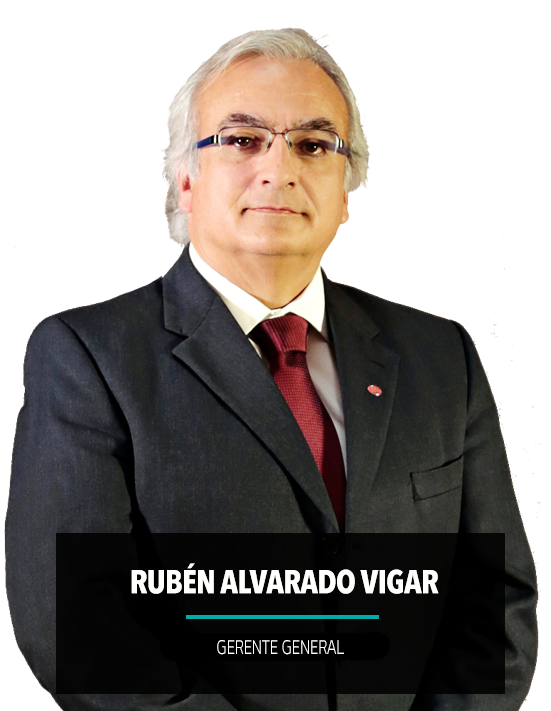
LETTER FROM THE CEO
In its 45 years of existence, Metro has been known for being a reliable company cherished by Santiago residents. However, in 2014 we experienced some operational issues that really shook us, affecting our relationship with our ridership and prompting us to take important measures aimed at improving our management in a few key areas.
In December we announced changes to our corporate approach by placing our riders at the heart of all our efforts. We also implemented immediate measures in Maintenance, Operations, and Passenger Information.
These course corrections are in response to our role as the backbone in the Santiago mass public transit system. Given this role, the onus was on us to address the negative impact that service interruptions had on the public and the city’s overall operations. That is why our goal consists of reducing both the likelihood of failures occuring and their impact on passengers.
Having set our new course, we began moving forward toward a more robust preventive and corrective maintenance management system, simply because a system as complex as underground rail is not fail proof.
Accordingly, we attacked the issue from two fronts: stabilizing the system on the basis of post-service interruption diagnostics, and identifying critical failure points in order to minimize the likelihood of high-impact failures reoccurring.
In conjunction with the above, we conducted a thorough review of the network’s status entailing in-house analysis, external reviews conducted by both domestic and international consultants, and opinions of employee representatives.
We used this diagnostic review as the basis to draw up a work program aligned with the company’s new approach, thereby laying the foundation for Metro’s new administration. With this goal on the horizon, once again we set our course toward developing projects that will provide us with defi nitive solutions and improve our operations in the various areas being addressed.
We know that it is impossible to guarantee a failure-free system; however, having said that, we are working day and night to limit them—and their impact in the event they do occur—to a bare minimum.
We have also worked on bettering our passenger information/communication system in order to foster a more continuous commute for our passengers in the event of service contingencies.
This also involves improving the degree of coordination between Metro, the Metropolitan Department of Public Transportation (DTPM) and other regional bodies.
Short-term targets were set for the area of Passenger Communication. These measures are already in place and have been applied to partial service interruptions or contingencies. Setting up informative screen displays at access points, distributing pamphlets to Metro users, employing the InfoMetro system which provides riders with surface level transit information are a few of the actions taken thus far to ensure that our riders may continue their commute in the most informative and normal fashion possible. This is our way of regaining riders’ trust and appreciation, and becoming the world’s least defective underground train system.
Apart from the negative incidents casting a shadow over 2014, there is some good news, for example, we began construction on the shafts and galleries for our new Lines 3 & 6. Toward the year’s end, President Michelle Bachelet announced a plan to extend Lines 2 & 3, which will also bring benefits to the El Bosque, San Bernardo and Quilicura communities.
Building new lines and extending existing ones, as announced by the Head of State, constitutes the most ambitious project ever undertaken by the company, directly benefiting 14 districts with more than 1.75 million inhabitants whose quality of life will improve.
These new lines will provide high-tech, world-class safe and efficient rail service, including, for example, replacing electrified tracks with an overhead power cable system that will feed train electric power from above; air-conditioned cars, security cameras, and automated driving.
These projects are a reflection of what Metro stands for, i.e., a state-owned company committed to the people and the city. We know that our riders need a comprehensive service, which is why we continuously strive to provide better underground rail service but we also invest our energy in broadening the coverage of our bip! Card loading system, so that users have the option of loading their cards where they go about their daily business, to mention one of our several projects.
2015 will mark 40 years since Metro’s virgin trip. Santiago residents can rest assured that everyone of us working at Metro will continue to do our best to provide better services, because that is what we set out to do every day.
MILESTONES












January
Construction began on the shafts and galleries of new Lines 3 & 6
A site visit to the shaft of the future station Lo Valledor, Metro de Santiago, marked the beginning of the construction phase of the shafts and galleries making up new Lines 3 & 6, is constituting the most important undertaking in the company’s history.
Metro announced its plan to improve the system to load and sell its bip! Card
After taking over the administration of the bip! Card in July 2013, Metro de Santiago announced its plan to improve card-loading services and thereby optimize the experience of users of the capital’s mass transit system.
The plan entails adding new card loading centers to the network, relocating some existing ones to areas currently without any service, adding an on-line payment option, and a tourist card, among other initiatives.
Metro’s safety processes become ISO 9001 certified
As part of its ongoing efforts to provide riders with quick, safe and reliable services, Metro de Santiago certified its planning, execution and control processes under ISO 9001.
ISO 9001 is an international standard for quality managements and, in Metro’s case, underscores the fact that all Metro’s service-related processes are carried out in keeping with detailed planning, controlled conditions and ongoing monitoring to allow for improvements.
Metro receives the “Movilidad” award for improvements at the Tobalaba Station
For having instituted and carried out actions contributing to creating better access and mobility for public transportation users, Metro de Santiago receives the “Movilidad” award granted by the Ministry of Transportation and Telecommunications.
The company received recognition under the “Access to Public Transportation” category for its work on the incoming track door at Line 4’s Tobalaba Station, which makes for easier and more orderly movement of passengers and quicker clearing of the platform.
February
In an unprecedented move, Metro issued a US$500-million bond on the international market.
For the first time ever, Metro de Santiago issued a bond on the international market in New York for a total of US$500 million in order to finance construction of future Lines 3 & 6, in addition to other projects to revamp its network.
This move opened up new markets for the company’s future financing needs.
Metro became the official transportation service for the 2014 Odesur Games held in Santiago
Pursuant to a cooperation agreement by and between the Ministry of Sports, the 2014 Santiago South American Games Corporation and Metro, the underground rail company becomes the official means of transportation for the Odesur games.
Metro launched Web pay, an on-line bip! card loading service
Metro de Santiago took a step forward in its quest to expand its remote bip! Card-loading services by launching Web pay, a 24-hr, on-line payment service for capital city commuters.
March
Suecia Street is reopened for use by the public after construction works on Line 6 are completed
As an example of Metro’s commitment to the community and public transportation, the company reopened traffic on Suecia Street, between General Holley St. and Providencia Av., a section of road that had been closed off in January and February due to construction on the new Line 6 Los Leones terminal station.
In its efforts to cause the least amount of vehicular and pedestrian traffic interruptions possible, Metro cut back the original time allotted to the first phase of its work schedule from four months to two months, and did the work over the summer in order to lessen its impact.
Technology will make it easier for visually impaired commuters to ride the rail.
At its Santa Lucía Station the Metro de Santiago launched its new Audible Information System called “Te Guío,” which aims to foster autonomy and improve accessibility for visually impaired riders.
April
Company launched action plan to improve existing transportation services and provide new ones
Operational and safety-related innovations, new passenger-information and -service measures, more cultural activities, and other actions, were among the items listed under the Action Plan announced by Metro in April. The plan entails 20 initiatives aimed at improving its customers’ experience and strengthening their ties with the city.
Included among measures announced is the addition of more air-conditioned trains, expansion of the express service to the entire Line 5 and installation of video screens at the entrance/exit points of the busiest stations for information purposes.
Line 5: Express services are expanded to the entire Line and information videos screens set up on platforms
By adding express trains to Line 5’s Pudahuel/Plaza de Maipú section, Metro was able to increase transportation services by roughly 25% and take an 8% off the total commute time to the Plaza de Armas.
In addition to the above, Metro set up a real-time information system providing users with travel-related information so they may better plan their commute.
First train retrofitted with AC is put into service
As part of its corporate action plan aimed at improving commuters’ ride, Metro put the first AC-retrofitted train into service on Line 1.
This initiative is the first step of a project to install AC on 35 trains, and in the end retrofitting all trains running on Line 1 with air conditioning.
Metro accessibility plan moves forward: New elevators installed at the Rondizzoni Station
As part of its Universal Access Plan, Metro installed two elevators at the Rondizzoni Station, making it the first of the older stations on Line 2 to have this amenity. Now mobility-impaired community members and area users will enjoy an easier commute and better quality of life.
Metro’s new Board and Chairman
At Metro’s Regular Shareholder’s Meeting a new corporate board was appointed, comprised of Aldo González Tissinetti, Carlos Mladinic Alonso, Juan Carlos Muñoz Abogabir, Vicente Pardo Díaz, Karen Poniachik Pollak, Paulina Soriano Fuenzalida and Claudio Soto Gamboa.
Subsequently, at the Board’s first meeting it appointed Aldo González Chairman of the Board.
Metro and MOVILH promote a pro-respect and diversity campaign
Metro de Santiago and the NGO MOVILH launched a network-wide campaign under the slogan “Where there is respect, discrimination doesn’t come on board,” with a view to taking on discrimination from different angles.
The campaign aims to create awareness among users and educate underground rail passengers in order to prevent discriminatory acts from occurring within the network and beyond.
May
Metro facilitates TNE revalidation by equipping 85 stations with the necessary means to do so
In order to facilitate the revalidation of the National Students’ Card (TNE) for Metropolitan region elementary, middle school and high-school students, Metro de Santiago and Junaeb opened up 85 points along the Metro network where students can validate their card.
The International Red Cross commemorates 150 years of humanitarian action at Metro facilities
In Chile the International Red Cross and Red Crescent celebrated their 150 years of helping the most needy around the globe, and chose Metro de Santiago as the public platform to showcase their work and invite Chileans to join them in their humanitarian efforts.
Chile’s President announces feasibility studies for expanding Lines 2 & 3
While standing at the future Los Libertadores Station of Line 3, Chilean President Michelle Bachelet announced the feasibility study for expanding Lines 2 & 3 towards Quilicura, El Bosque and San Bernardo.
June
Line 2 puts in a real-time passenger information system
Line 2 joined the ranks of Lines 4 & 5, which already carried this technology. The purpose of this system is to meet riders information needs during their commute by providing them with timely information on platform screens.
Universidad de Chile Station is recognized for being one of the world’s pretties
The BBC ranked the Santiago Metro’s Universidad de Chile Station among the seven most attractive metro stations worldwide.
The ranking highlighted the large murals painted by Chilean artist Mario Toral as par of his “Visual Memory of a Nation” series in which he depicted Chile’s national history on 1,200 m2 of a veritable visual narration.
July
Metro takes part in a project to spread scientific awareness
Metro de Santiago, Federico Santa María Technical University and CONICYT’s EXPLORA Program joined forces with a view to making scientific work more well known by way of the project entitled “Nunatak Chile: a natural laboratory on glacial pollution” located at Line 5’s Baquedano Station.
A new train car model for Lines 3 & 6 is inspected
A delegation led by Metro’s Chairman paid a visit to the manufacturing facilities of the Spanish company CAF where the new Line 3 & 6 trains were to be manufactured. The purpose of the visit was to inspect the new car model and make sure it met the project’s technical specifi cations. This inspection was the necessary preliminary step in building the cars that are to be used on the future lines.
Metro names the future Line 3 station after former Mayor Castillo Velasco
As part of a wider effort carried out by the Municipality of La Reina in which it changed the name of the Tobalaba-to-Parque Mahuida section of Larraín Avenue to honor former Mayor Fernando Castillo Velasco, Metro de Santiago joined the effort to pay homage to the architect and former Intendent by naming the future Line 3 terminal station after him as well.
Explosives go off on an empty car at the Los Dominicos Station
A car located at the Los Dominicos station was damaged after an explosive device detonated in one of its cars close to midnight. The event occurred after service hours, which is why no injuries were reported.
Metro begins its community visits program for the new lines
With a view to strengthening ties with the communities in which new lines 3 & 6 will be built, Metro launched a worksite community visit program in order to make the community more familiar with the project’s progress.
This initiative is part of a series of other public relations activities constantly carried out by Metro, and that are primarily aimed at a neighborhood groups, community leaders, the business community and residents located in areas near future station worksites.
August
Company launches the SMS 1411 system as part of its safety-improvement framework
Metro de Santiago published a series of measures aimed at improving the safety of its network for the benefit of riders using the system daily. The company highlighted the new 1411 SMS service available to commuters so they can quickly and privately report on events that may affect their safety during their ride.
This activity took place at the Los Dominicos Station— the same one affected by the explosive device that went off in July 2014.
Ministry of Justice and Metro unveiled murals painted by SENAME foster children
Six new works of art painted by foster children living at the SENAME-run Galvarino Center were installed at Line 2’s Ciudad del Niño Station at commemorative activities held during the Month of Childhood and Adolescence. These works of art are part of a nine-part series of works that will become part of permanent exhibition that has been in place at this station since 2005, as part of the MetroArte program.
Breakdown affects operations at five stations along Line 4
A crack in a track-switching device located at the intersection of Quilín and Las Torres on Line 4 caused service interruptions between the Vicuña Mackenna and Los Presidentes Stations.suspensión de la operación entre las estaciones Vicuña Mackenna y Los Presidentes.
Power shortage along Line 5 tracks made it necessary to evacuate 50,000 people
Simultaneous breakdowns of several components of the centralized command and control systems providing power to the tracks resulted in a forced two-hour shutdown of services between the Quinta Normal and Plaza de Maipú Stations.
September
Explosive device goes off at the Subcentro shopping center
Fourteen people were injured when an explosive device was detonated at the “Subcentro” shopping center located at the Escuela Militar Station. After conducting a thorough search, Metro and police authorities proclaimed the area safe for passengers.
Metro’s Board of Directors appoints a new CEO to head up the company
Metro de Santiago’s Board of Directors appointed Rubén Alvarado Vigar as the company’s new CEO.
October
Metro launches the Keep a Breast foundation in Chile with a show
In order to create more awareness among young women as to the need for early detection of breast cancer and self-exams, the US-based foundation Keep A Breast made its presence in Chile offi cial with an exhibition located at the Quinta Normal Station along Line 5.
The show involved a display of 19 plaster busts of well-known women from television, politics, the music industry and show business, such as Ximena Rincón, Karen Doggenweiler, Katty Kowaleczko, and Diana Bolocco. The plaster molds were then intervened by prominent Chilean visual artists such as Bororo, Totoy Zamudio, Carmen Aldunate, and Matilde Huidobro.
Metro and Mutual de Seguridad launch a campaign to promote good behavior
Metro de Santiago, the Chilean Chamber of Construction’s Safety Cooperative Mutual de Seguridad and the Metropolitan Department of Public Transportation (DTPM) developed the “Use Your Good Side” campaign to foster good behavior and selfawareness among passengers in order to prevent accidents on board.
November
President Bachelet announces Lines 2 & 3 will be extended
President Michelle Bachelet announced the addition of 8.9 kilometers and seven new stations to Metro’s network. More than 600,000 inhabitants will reap the benefi ts of Lines 2 & 3 being expanded into El Bosque, San Bernardo and Quilicura. This initiative is part of the public transportation infrastructure investment plan announced by the President herself.
President Bachelet also reported that studies will be conducted to assess the viability of adding another line to the system with a view to easing Line 1 congestion.
Breakdown shuts down service on Lines 1, 2 and 5
A service failure was caused by short-circuited power cables feeding Lines 1, 2 and 5, resulting in the closure of all stations servicing these three lines and the evacuation of all cars on the tracks. Service was gradually restored.
Rodrigo Azócar steps up as Metro’s new Chairman of the Board
Metro’s Board of Directors named Rodrigo Azócar Hidalgo as the company’s new president, as a replacement for Aldo González Tissinetti.
New information displays are installed at station access points
Metro de Santiago installed screens displaying real-time information for its riders at station access points. Seventy-eight (78) displays in total were installed at 44 station entrances throughout 18 different stations tagged as priority stations because of their importance, traffic and connectivity.
The purpose of this initiative is to let riders know what the station and network status is prior to entering the station and buying a ticket.
Banco de Chile set up donation kiosks at Metro stations to support the Teletón
Teletón, Banco de Chile and Metro de Santiago joined forces once again to meet the target. For the fourth consecutive year, the bank set up donation kiosks in the underground system in order to reach out to passengers who use this means of transportation daily. This time around Banco de Chile installed its devices at 30 Metro stations, three more than the total number installed during the 2012 campaign.
December
Metro firma el mayor contrato bancario internacional de su historia por un total de US$800 millones
El contrato fue suscrito con un sindicato de bancos, con BNP Paribas y Sumitomo Mitsui, como agentes de la operación. El crédito financiero, por US$250 millones, encabezado por Sumitomo Mitsui como Facility Agent, será destinado al financiamiento de las obras civiles, suministros y otros gastos asociados a la ejecución de los proyectos de expansión de la red. Respecto al crédito comprador por US$550 millones, encabezado por BNP Paribas como Facility Agent, será destinado a financiar los equipos, material rodante y otros gastos de los proyectos de expansión.
Metro cambia enfoque de gestión incluyendo medidas para minimizar impacto en pasajeros ante suspensión del servicio
Con el objetivo de disminuir los efectos que la suspensión de su servicio tiene en la población y en la ciudad, Metro de Santiago dio a conocer su Plan de Mejoramiento de Gestión de Fallas de Alto Impacto, que se enmarca en un nuevo enfoque de gestión de la empresa.
La iniciativa, que recoge los análisis internos, las sugerencias planteadas por el Comité de Expertos, la mirada de los trabajadores y las mejores prácticas internacionales, busca reducir la tasa de fallas y el tiempo de restablecimiento del servicio cuando ocurran este tipo de situaciones, a través de acciones de corto y mediano plazo en las áreas de mantenimiento, operación y comunicación a pasajeros.
Metro implementa plan especial de seguridad en vísperas de Navidad
Con motivo de la campaña “Denuncia Segura” de la Subsecretaria de Prevención del Delito en las inmediaciones de la estación Cal y Canto de Línea 2, Metro de Santiago dio a conocer su plan especial de seguridad para los días previos a la celebración de la Navidad.
Se presenta pique alternativo que evita intervención en Plaza de Armas frente a Catedral de Santiago
Luego de realizar diversos estudios para modificar la ubicación del pique de construcción de la futura estación Plaza de Armas de Línea 3, contemplada inicialmente en Plaza de Armas frente a la Catedral, Metro de Santiago presentó una solución para emplazar la nueva obra en la calle Puente.
Esta alternativa fue producto del diálogo sostenido entre la Intendencia Regional, la Municipalidad de Santiago y Metro de Santiago, entidades que valoraron el esfuerzo y trabajo conjunto para encontrar una vía satisfactoria.
Nuevos ascensores en 5 estaciones
A partir del proyecto de accesibilidad de Metro, comenzaron a operar los nuevos ascensores de las estaciones Salvador, Ciudad del Niño, San Miguel, Universidad Católica y Manuel Montt, facilitando el desplazamiento de los pasajeros con movilidad reducida.
Metro signs its most important international banking agreement of all times for a total of US$800 million
Metro signed a syndicated bank loan with BNP Paribas and Sumitomo Mitsui as operational agents. The US$250 million in financial credit handled by Sumitomo Mitsui as the Facility Agent, will be earmarked for financing civil works, supplies and other project-related expenses linked to network expansion efforts. As for the buyer’s credit for US$550 million, lead by BNP Paribas as Facility Agent, will finance equipment, rolling stock and other expansion project expenses.
Metro changes its approach to include measures that aim to minimize the impact of service interruptions on passengers
With a view to diminishing the effect of service suspensions on riders and the city as a whole, Metro de Santiago announced its Plan to Improve Management of High-Impact Failures, which is framed by the company’s new administrative approach.
This initiative combines in-house evaluations, suggestions put forth by the Committee of Experts, workers’ perspectives, and the best international practices in order to reduce the failure rate and service restoration time after service interruptions occur. The plan involves taking short- and medium-term actions in the areas of maintenance, operations and passenger communications.
Metro implements a special safety plan for the Christmas season
As part of the “Reporting Safely” campaign spearheaded by the Office of the Undersecretary of Crime Prevention with a view to making the areas surrounding Line 2’s Cal and Canto Stations safer, Metro de Santiago announced a special plan for the days running up to the Christmas Holiday.
An alternative shaft is proposed in order to avoid excavating in the Plaza de Armas facing the Santiago Cathedral
The construction shaft for the future Plaza de Armas, Line 3 Station was originally planned to be dug directly in front of the Santiago Cathedral. However, following several studies conducted to find an alternative location, Metro de Santiago finally came up with a solution to the problem and announced its decision to relocate the works to Puente Street.
This alternative solution emerged after ongoing discussions between the Regional Intendent’s Office, the City of Santiago and Metro, all of which appreciated the combined effort to find a satisfactory solution.
New elevators at five stations
As part of its universal access project, Metro installed elevators at the Salvador, Ciudad del Niño, San Miguel, Universidad Católica and Manuel Montt Stations in order to ease the commute of mobility-impaired riders.

SCOPE AND COVERAGE
REPORT COVERAGE
[[G4-29, G4-30] For the sixth consecutive year, Metro de Santiago issues a Sustainability Report as part of its commitment to transparency and clear, robust communication with its stakeholders.
[G4-28] Our Sustainability Report aims to report to the public on the company’s management, performance and results regarding economics, corporate governance, and social and environmental affairs over the January-December 2014 period. The report’s structure is aligned with the seven prongs of Metro’s sustainability strategy, to wit: customers, collaborators, suppliers, urban setting, community, environment, corporate governance, and financial sustainability.
[G4-6 & G4-17] Metro’s scope of action is limited to the Santiago Metropolitan Region, specifically Greater Santiago, and so is the report. The report refers to the operational and expansion activities of Empresa de Transporte Metro S.A. , in addition to the performance of the MetroArte cultural organization (Corporación Cultural MetroArte), but it does not contain any information regarding Corporación Metro Ciudadano or Metro’s subsidiary, Empresa de Transporte Suburbano de Pasajeros S.A. (Transub S.A.).
[G4-13] It is worth noting that there weren’t any significant changes applied to the company’s size, structure or ownership over the course of the report period that would have affected the information disclosed.
[G4-32] This report was drafted according to the “essential” option of the fourth version (G4) of the Global Reporting Initiative (GRI) Guidelines, however, the company reported on many more corporate governance indicators than those required under this category.
[G4-15] Metro is a signatory to the United Nations Global Compact through which it has aligned its strategies and operations with the ten principles outlined under the Compact in reference to human rights, labor standards, the environment, and anti-corruption. Metro’s uses the Sustainability Report to inform the public of the commitments it has adopted under the Global Compact and as the Communicator of Progress (COP).
[G4-33] Information contained herein has been validated by Metro’s senior management but not by outside parties.
Identifying Relevant Issues for the 2014 Report
Materiality Process
The last version of the GRI’s G4 Guidelines emphasized the leadership role adopted by organizations in incorporating sustainability, the importance of the value chains, and identifying material aspects, all with a view to encouraging organizations to disclose information and publish indicators that are relevant to their business and stakeholders.
The GRI’s G4 Guidelines define materiality as “aspects that reflect the organization’s significant economic, environmental and social impacts; or issues that substantively influence stakeholder assessments and decisions.”
[G4-18] Although the previous Report was drafted according to the G3.1 methodology, it did entail a materiality process. This year we have employed the help of a consultant who has aided us in delving deeper into the process of defining material aspects by following GRI’s G4 Guidelines and applying the principles of Stakeholder Engagement, Sustainability Context, Materiality and Exhaustiveness, as recommended by that methodology.
The most relevant aspects were identified by following the four the main steps laid our under the GRI G4 Guidelines:
SHOW GRAPH

Identification (& Review)
Identifying relevant aspects begins with a review of the previous Report and aspects identified and disclosed thereunder. This review becomes the basis of the new identification process and is especially relevant for Metro because this Report is the first one written according to GRI’s G4 Guidelines.
The following activities were carried out in order to determine which aspects are most relevant to the company and its stakeholders, to wit:
Comparative Analysis: three metro systems from around the world were used as a benchmark to identify the sectoral context of sustainability. The benchmark analysis focused on Asia, given similarities in terms of age and expansion phases. In addition, the same comparative exercise was carried out with three Chilean companies in order to better understand sustainability in the Chilean context.
Internal Business Analysis: Metro also conducted an analysis on its secondary business data including strategies, codes, policies, studies and surveys, presentations, reports and annual reports, which led the company to identify economic, social and environmental aspects that are relevant to business development.
It is worth noting that along with the abovementioned data reviews, the company also interviewed the Chairman of the Board, the CEO and seven other area managers in order to understand their take on sustainability within the company.
External Review: In the context of the Sustainability Report for the first ever Metro conducted ten interviews with some of its external stakeholders, including Chilean authorities, customers, suppliers, community members and civil society representatives. The outcome was quite valuable in that the interviews allowed the company to identify which Metro-related aspects are relevant to its stakeholders. Moreover, the company conducted a 2014 press review.
Prioritization
All aspects identified the first time around were subject to further analysis to determine their degree of economic, environmental and social relevance to Metro, and then they were categorized and put into a chart in order to have a visual take on which ones were more relevant to the company and its stakeholders. This categorization took place during a Materiality Workshop held for Metro employees from a variety of different areas such as human resources, maintenance, operations, planning, projects, and environmental, community and public affairs.
Validation
The chart was validated internally at a workshop held with senior executives from different areas.
[G4-19] Relevant Aspects Chart
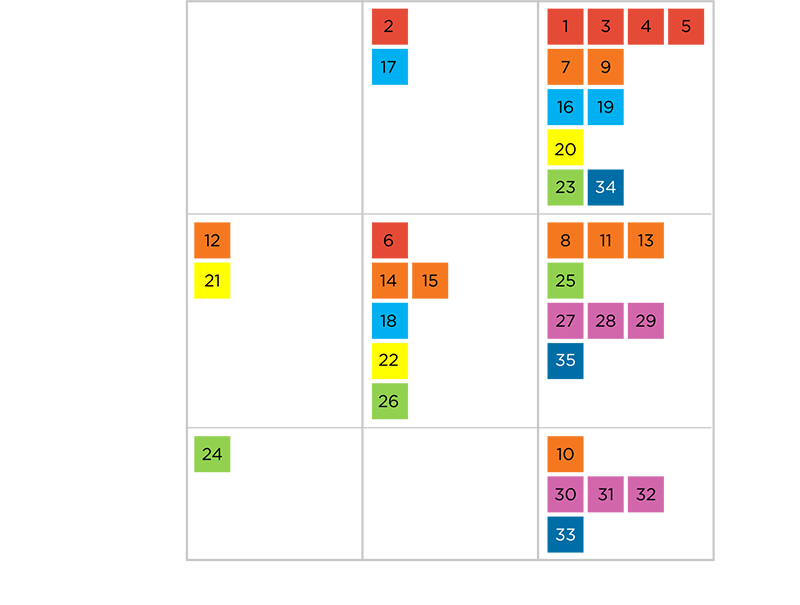
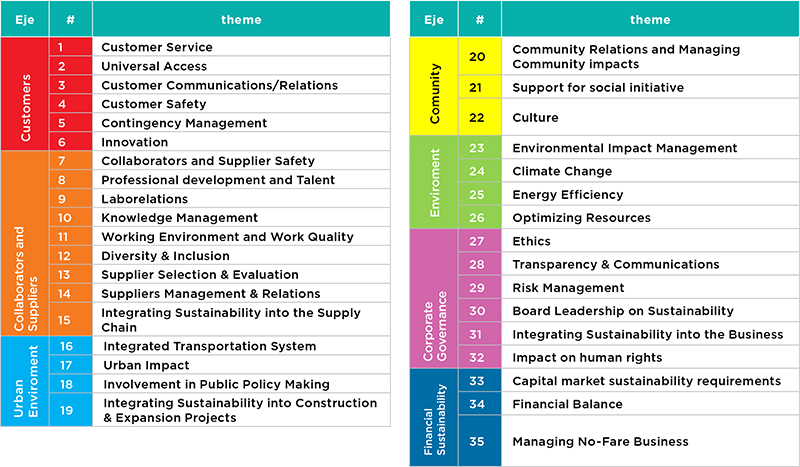
Coverage of (Relevant) Material Aspects
[G4-20, G4-21] The G4 methodology places emphasis on areas along the value chain where the economic, social and environmental impacts occur, thereby making it necessary for organizations to not just address relevant aspects in their own business. Metro classifies the coverage of relevant aspects according to its operations and expansion projects underway. External coverage of material aspects is classified according to the key stakeholders identified by the company.
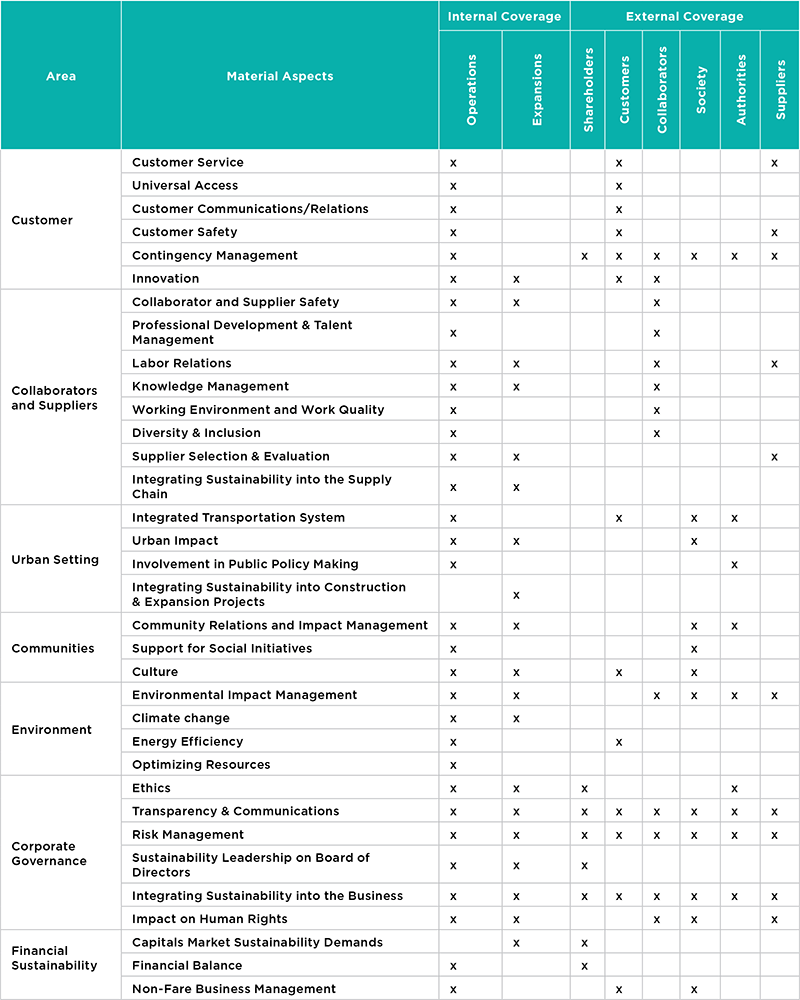
[G4-22, G4-23] There haven’t been any changes to the scope or coverage of the material aspects covered herein since this is the first report drafted under this methodology.

ABOUT US
Metro is the main artery of Santiago’s public mass transit system accounting for over 60% of all public transportation travel. Bearing in mind the relevance of Metro to urban development, the company aims to provide services that constitute a positive contribution to the lives of city residents while striving to make efficient use of public resources. Metro has made an outright commitment to the city of Santiago and its future by working on a variety of different fronts.
Metro’s Structure
Ownership
[G4-7] Metro is owned by the Chilean State by way of two shareholders, to wit, Corporación de Fomento de la Producción (CORFO) with a 62.75% share, and the Chilean State, represented by the Ministry of Finance, with a 37.35% share.
Capital increases issued and paid up have resulted in slight changes to the ownership structure over the years as illustrated in the table below:

Subsidiaries & Partners
Metro’s only subsidiary is Transporte Suburbano de Pasajeros S.A. (Transub S.A.), and this company is not in operation.
Metro is a member of Corporación Cultural MetroArte, a private non-profit organization working to promote culture and education within the community through art installations located throughout the Metro transportation network and nearby facilities. Metro is also a member of Corporación MetroCiudadano, another private, non-profit entity that organizes, coordinates and carries out projects related to the environment, urban improvements, modal integration, education, sports, recreation, and universal access.
Mission, Vision & Values
Mission
As a main artery of the public transportation system, our mission is to guarantee that customers riding on electric-powered rail have a sustainable, efficient, quality, reliable and safe commute.
In addition, we also aim to provide supplementary services that boost the company’s profit and help finance its expansion, while also making the lives of city residents better and ensuring the efficient use of public resources.
Vision
Our vision is to be a state-owned company respected by citizens for being efficient, safe and providing a valuable service.
To be known as a company staffed by very good professionals and that is managed on the basis of merit.
Values
Our values are based on five key principles, which shape and guide the decisions and actions of every individual working at the company. These principles are complementary and constitute a combination of what Metro personnel are made of and aspire to be.
Customer Care: we strive to be one of the best service-sector companies in the country.
Safety: your safety comes first.
Efficiency:we want to a role model for other metros elsewhere.
Collaboration: we make more forward progress when we work together.
Transparency: transparency is behind everything we do.

OUR COSTUMERS & SERVICES
Services
[G4-4] Metro’s goal is “to carry out all activities inherent to metropolitan passenger rail transportation services or other complementary electric-powered media and other activities related to this sector, while also being able to conduct any act or operation related to our social purpose.”
We also have non-fare side businesses ranging from leasing shops, commercial and advertising space to consulting services abroad, and the Bip! Card business. Advertising on the trains and at the stations constitutes an important non-fare business. At present this side business is run under outsourced concessions.
Companies leasing stores and commercial space at the stations are important Metro customers. In 2014 this customer base consisted of telecom, retail, advertising, real estate, and service companies, as well as intermodal stations and consulting firms.
Metro’s Network
[G4-8] Metro’s network currently provides service to the following districts in Santiago:
SHOW GRAPH

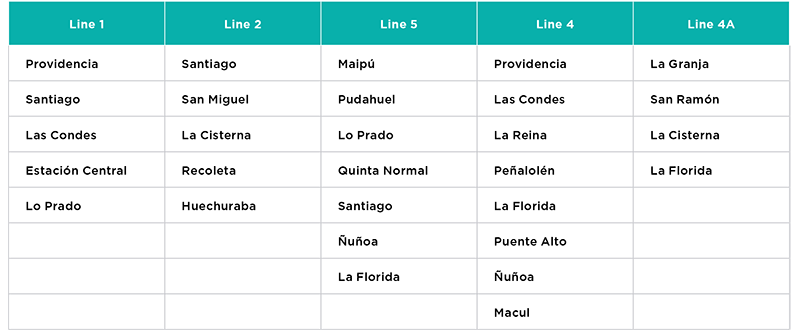
Operating Stats
Metro accounts for more than 60% of all public transportation travel.
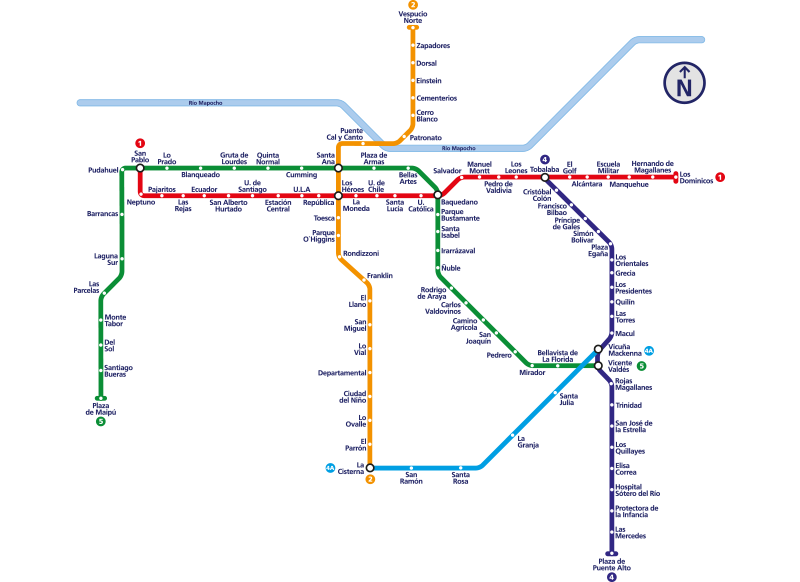
2.268 million trips on average per workday.
667.6 million trips
Regularity Figures
SHOW GRAPH

103 km of track
A fleet of 1,093 cars
108 Stations
1 depot
Our Customers
[G4-8] Line 1, 2, 4, 4ª and 5 riders constitute the bulk of Metro’s customers. According to the 2014 Chile3D Study conducted by GfK Adimark, Metro’s customers can be broken down as follows:
SHOW GRAPH
SHOW GRAPH
SHOW GRAPH




OUR PLANNING
2014 Strategic Areas & Priorities
Ever since 2011 Metro has focused its activities on three main strategic areas, each of which has its own list of specific goals that were set by the Board of Directors and the Mangers Committee.
SHOW GRAPH

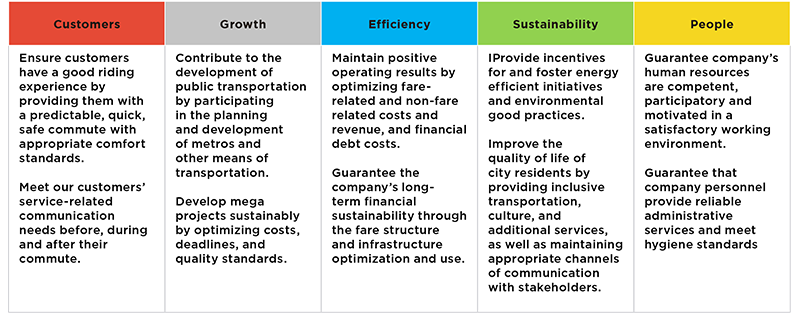
Each year the company defines its strategic projects on the basis of the above. These projects aim to close the gaps between current and expected performance levels so that the company will meet its goals.
In 2014, these projects were primarily aimed at improving our commuters’ riding experience, developing network expansion projects, and managing our workers.

Sustainability Management
Sustainability is both a strategic and crosscutting area in Metro, which is why the company is determined to weave it into its daily existence and employ it as a Corporate Social Responsibility (CSR) tool.
Metro defi ned its Sustainability Strategy in 2012, and ever since then the company has worked towards integrating sustainability into the various areas of its business. The company hit an important milestone in 2014 when the Board of Directors implemented the Sustainability & CSR Policy.
Given Metro’s crucial role in the Santiago public transportation system, this Policy is key in that it provides a fourth dimension—the urban dimension—to Metro’s traditional sustainability efforts in economic, social and environmental areas. It also defi nes seven strategic areas related to the main dimensions.
SHOW GRAPH

The Policy defines specific commitments for each area, as follows:
Based on the methodology, a leader was appointed to head up each individual area. Leaders are responsible for attending meetings, making decisions, and discussing material aspects pertaining to sustainability and corporate social responsibility. Moreover, a series of indicators were set for each area as an administrative tool to follow up on sustainability actions.
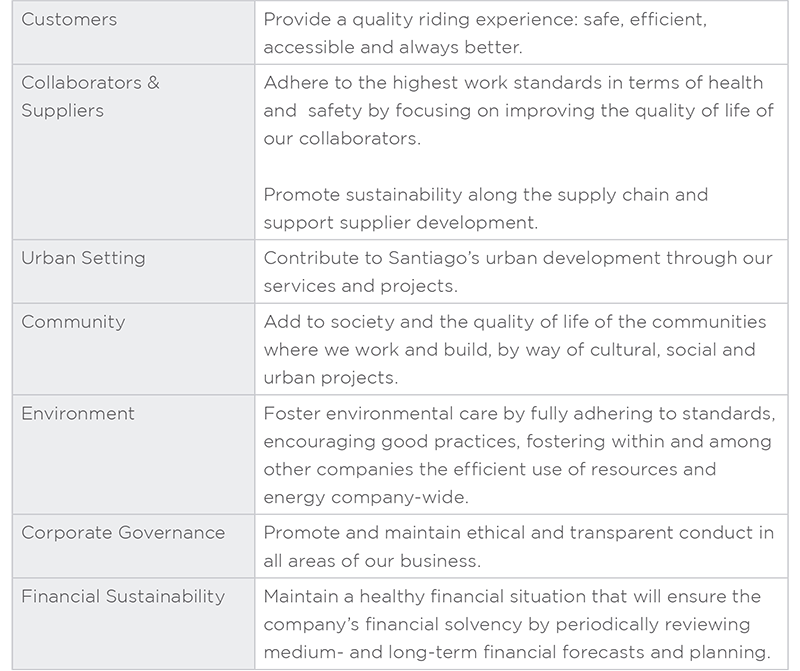
2014 Commitments
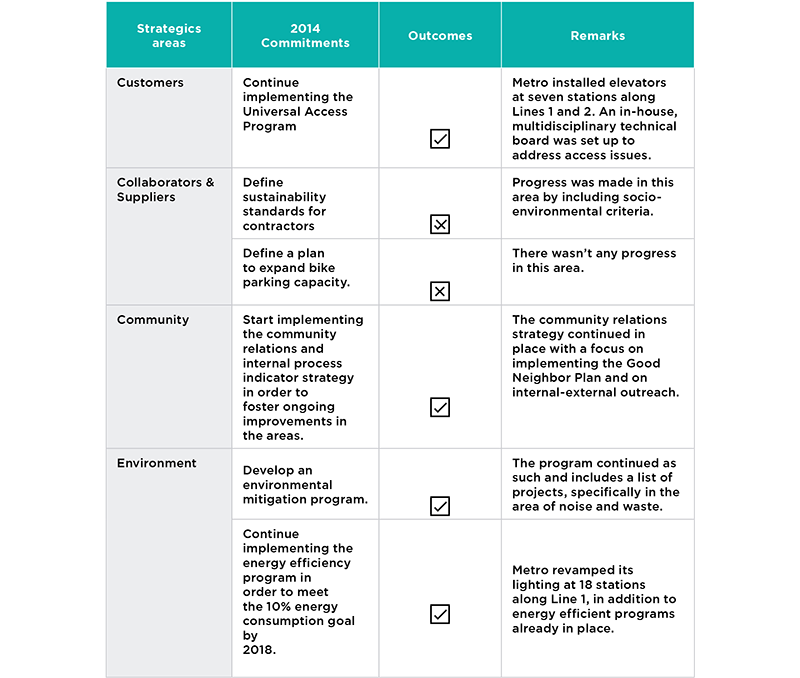

OUR STAKEHOLDERS
As a main artery in Santiago’s public transportation system, we interact with a wide variety of key players in order to attain our goals in all areas of our business.
[G4-24 & G4-25] In 2010, Metro conducted an exercise to identify and prioritize its stakeholders. The latter has enabled us to focus our actions on their real needs and expectations. We continuously review and update our stakeholder map in order to meet their needs accordingly.
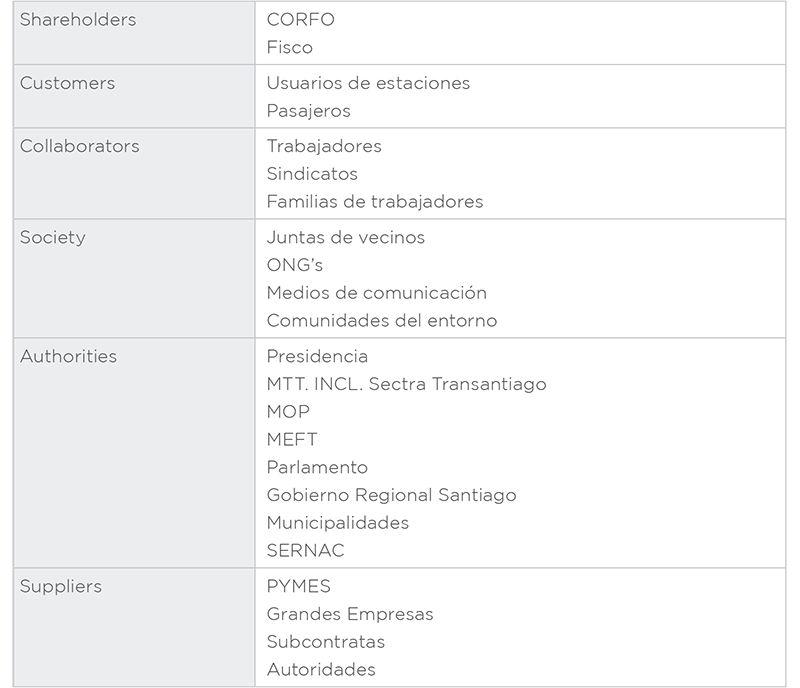
[G4-27] The table below contains a list of Metro stakeholders, management departments and the main areas involved with each group and their key issues.
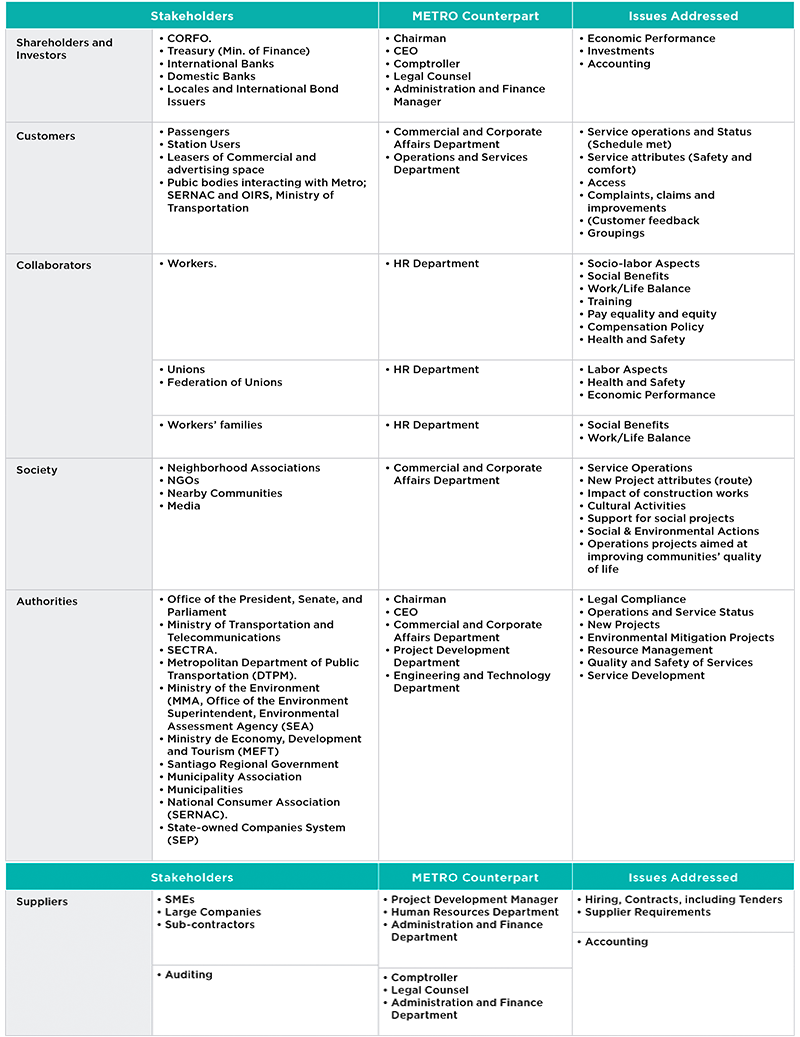
[G4-26] Stakeholder Communication and Participation
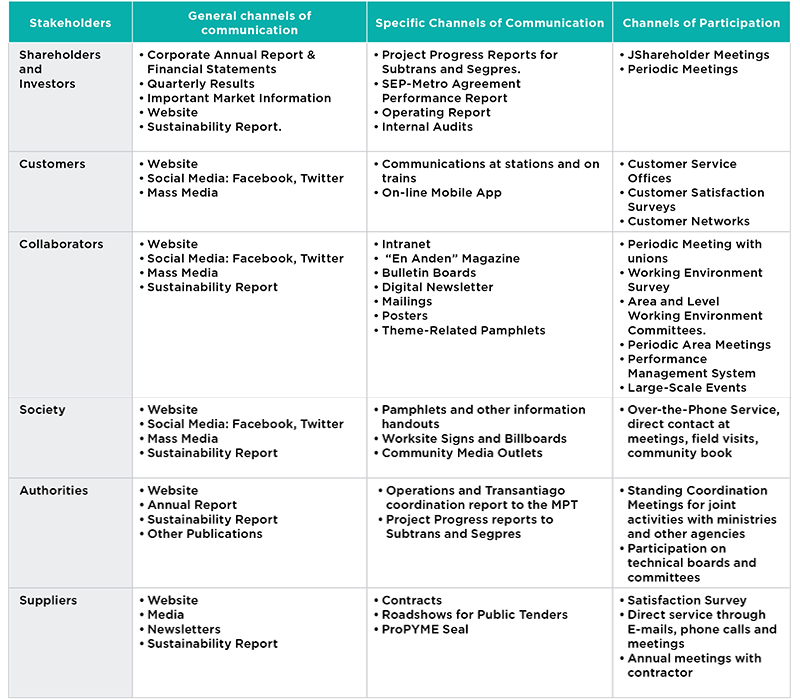
Associations
[G4-16] Metro is a member of several associations and institutions that espouse similar principles and share experiences, good practices and information with Metro.
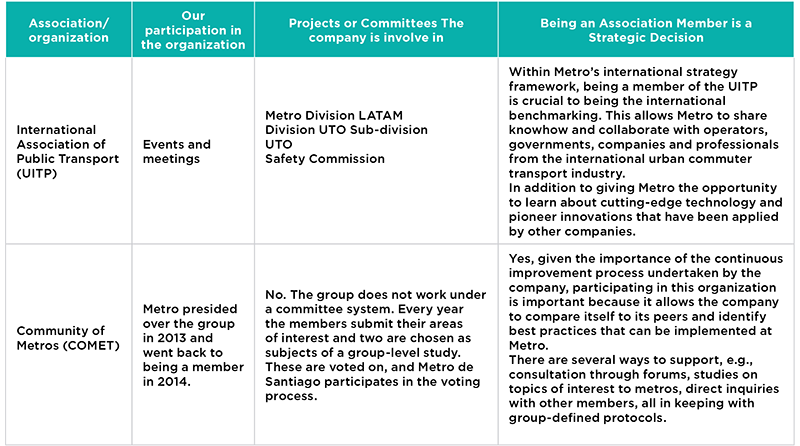
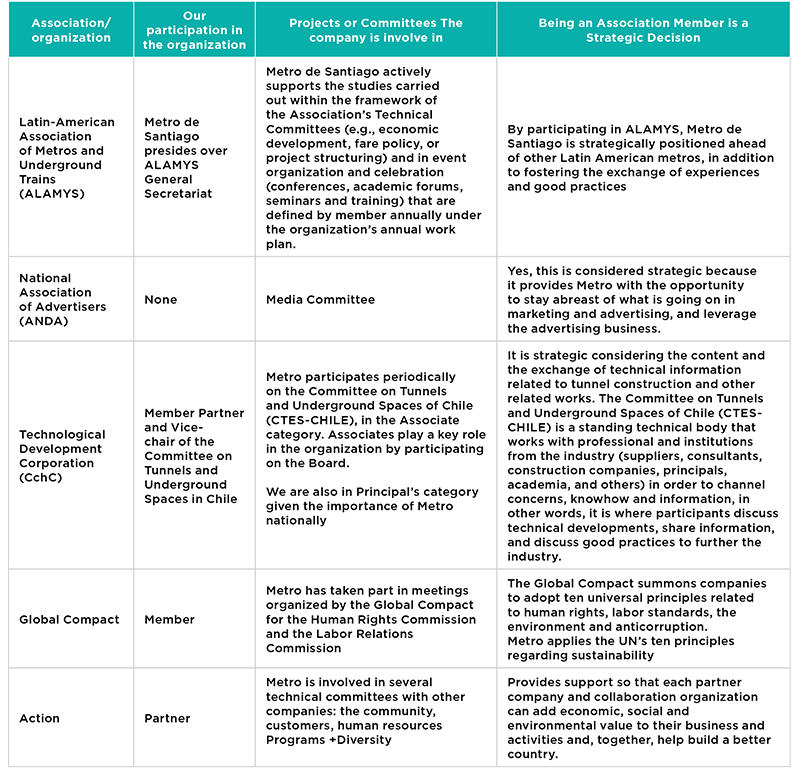

OUR BOARD OF DIRECTORS AND MANAGERIAL TEAM
Board of Directors
[G4-34] Metro’s Board of Directors is in charge of managing the company. Presiding over the Board is the Chairman, who is supported by a Vice-Chair and five board members. The CEO and a advisory body headed up by the Comptroller are subordinate to the Board of Directors.
The Board of Directors is made up of seasoned professionals from academia, business, and public policy/administration with a great deal of experience in their respective areas of expertise.
[G4-40] Board members are elected exclusively by shareholders as there is no other formal procedure to do so.
[G4-38] New board members were elected at the 23rd Regular Shareholders’ Meeting held in April. From that point onward, Aldo González Tissinetti took over as Chairman of the Board until board meeting No. 857 was held on November 15th during which the Board of Directors accepted his resignation and in stride appointed Rodrigo Azócar Hidalgo as both board member and Chairman of the Board.
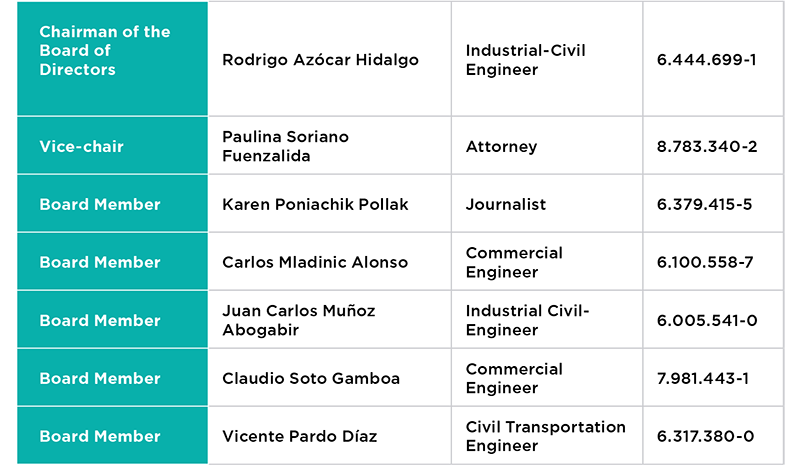
[G4-39] The Chairman of the Board and board members at Metro do not hold executive positions
Board Committees
The Board of Directors meets twice a month in addition to holding the meetings of the three board committees:
Project Management Committe: oversees guidelines applicable to new expansion and line projects.
Operating Committee: addresses strategic lines and manages the company’s business development, covering operational and service issues to planning and control, engineering and technology, human resources, and commercial matters.
Audit and Finance Committee: oversees management of the company’s financial resources to ensure their efficient use, in keeping with established procedures; its purview also includes being aware of the accounting criteria adopted by Metro and amendments thereto; and monitors internal auditing function and issues statements on the external auditor’s report of the company’s financial statements.
The aforementioned activities of the three committees are general in nature and are not exclusively limited to the above since these functions are dynamic and fluctuate according to changes in the business.
[G4-38] The Committees’ makeup in 2014 was as follows:
2014 Board Committees

The Chairman of the Board of Directors sits as a member on all board committees, and Cristian Ruiz Santibáñez is the Secretary of the Board of Directors and its respective Committees.
Managerial Team
[G4-35] The General Manager is in charge of managing the company through eight corporate departments and direct support from the legal department.
SHOW GRAPH

(*) Organizational Chart as of 31 December 2014.
Changes to the Managerial Team
In May 2014, the Board of Directors accepted Ramón Cañas Cambiaso’s voluntary resignation as Metro’s CEO. Former Administration and Finance Manager Hernán Vega Molina was appointed interim CEO until September 2014 when the Board of Directors named Rubén Alvarado Vigar to the position.
On 22 November 2014, Felipe Bravo Busta joined the managing team as Maintenance Manager, while Patricio Baronti Correa came on board as Human Resources Manager on 1 December 2014.
Compensation
[G4-51, G4-52] Board member compensation is both fixed and variable, the latter of which depends on meeting attendance, and shareholders determine the upper limit placed on board member compensation.
Board members do not receive any economic bonus for their managerial role or for the company’s economic performance. The chairman of the board, however, does receive a set monthly compensation.
Members of the managerial team receive a set monthly salary and are also enrolled in a performance plan that entails an annual performance-based bonus that takes into consideration the degree to which they meet the corporate and individuals goals set out for them annually by the Board of Directors. The 2014 Annual Report discloses Board Member and Managerial Team member compensation, and can be downloaded at: www.metrosantiago.cl/corporativo/ memoria.
It is worth noting that Metro board members and senior executives do not hold any capital shares in the company since Metro is entirely state-owned.

ETHICS & TRANSPARENCY
Ethical Guidelines
[G4-41, G4-56] As a state-owned company Metro is governed by the State-owned Company System (SEP) Code, which defines a Code of Ethics, a Manual of Principles and Good Corporate Practices, and other requirements applicable to board members, all with a view to preventing conflicts of interest among governing bodies.
The SEP Code of Ethics consists of a “set of values and ethical principles that are to serve as a basis for decision making, procedures, corporate culture and standards at state-owned companies, and is applicable to both board members and workers of state-owned companies.”
The Code covers the following areas:
Value-Seeking Corporate Governance and Guideline: applying and enforcing appropriate corporate governance practices that lend themselves to quality, efficient and effective administration aimed primarily at creating sustainable value.
Probity and trustworthiness: being honest and trustworthy in all company actions, negotiations and hiring activities, in addition to disclosing and avoiding any and all conflicts of interest.
Openness and transparency: acting in a clear, transparent and open manner that is accessible to all, and focusing on listening, engaging in dialogue, and cooperating.
Respect for the Political Constitution and Law: abiding by the law and ensuring correct and complete compliance with the Political Constitution, legislation and other applicable rules and regulations.
Respect for human rights: oshaping company actions around the principles outlined under the United Nations Universal Declaration of Human Rights and treating all company workers, contractors, customers, suppliers, competitors and individuals at large with respect and dignity, fairly and impartially, without arbitrarily discriminating against them on the basis or gender, age, ethic origin, political creed, religion, race, marital status or anything else.
Respect for workers and their organizations: complying with legal rules and regulations pertaining to workers’ rights, labor law in effect and collective bargaining agreements and contracts; respecting workers’ rights to unionize, and providing workers with a safe working environment.
Respect for the environment: pledging a commitment to sustainable development, environmental protection and avoiding or keeping to a bare minimum any negative impact company projects, operations or activities may have on the surroundings.
Corporate Social Responsibility: developing smooth and transparent relationships with communities where the company operates and abiding by ethical principles and current legislation when dealing with customers and suppliers.
The SEP Code also defines corporate governance principles for state-owned companies which are “institutional instances and practices that must be reflected in companies’ decision making so that when framed by transparency, ethics and corporate responsibility they contribute to creating sustainable value in the long term by fostering respect for all shareholders and stakeholders involved with the company.”
When enforced, these guidelines facilitate the tasks undertaken by other government agencies such as the Comptroller’s Office, the Superintendency of Securities and Insurance (SVS), the actual state-owned companies’ administrative control. Moreover, the “Guidelines to Corporate Governance for State-owned Companies” includes a self-assessment questionnaire that must be filled out annually by companies’ senior management, and it will be audited by the SEP starting in 2015.
The CAIGG (Government Council for General Audits), under the Office of the President of the Republic, also has control-related responsibilities.
Code of Ethics
[G4-56] In addition to the SEP Code of Ethics, Metro has its own Code of Ethics that describes the values and conducts that the company expects workers to uphold in their daily work activities.
The Code of Ethics covers the follows areas: individual and interpersonal ethics; ethical use of resources; ethics in business dealings; ethics in dealing with the public; and the scope of the code and sanctions.
Auditing
Metro has an internal auditing function that is periodically reviewed by the Internal Control Department, Independent Auditors and the Office of the National Comptroller. Given changes to the Board of Directors and the Managerial Team, as well as incidents taken place in 2014, the 2012-2014 Triennial Auditing Plan was postponed in order to provide the company with sufficient time to rewrite a new Auditing Plan for the 2015-2017 period. The purpose of the plan is to ensure that the financial controls set in place by the administration sufficiently mitigate risks. Likewise, the Legal Department conducted a study on Law 20,393 on the Criminal Liability of Legal Entities regarding the prevention of money laundering, financial terrorism and bribery.
Reporting Violations
[G4-58] Since 2012 Metro has been using an In-house Violation Reporting System where individuals can report events that may or may not constitute a crime or violate the Code of Ethics, Corporate Regulations or other Metro rules. The purpose of this initiative is to maintain the highest possible standards of ethics and probity. The site is confidential, reliable, and supported by an outsourced company.
The system is open to all workers and third parties who interact with the company. Reports may be made anonymously or not, sent through an Internet or Intranet website, E-mail or by letter sent to a P.O. box set up specifically for this purpose or directly to Metro S.A. authorities (Chairman of the Board, Controller, CEO, HR Manager, etc.). Workers have been informed of the reporting several different ways, to wit, Anden en Linea (digital in-house newsletter), printed pamphlets, corporate intranet, posters, and corporate induction programs.
Metro’s Comptroller is in charge of managing all reports received and ensuring that they are investigated and resolved. Work-related violations (discrimination, sexual abuse, abusing authority, etc.) are investigated by the HR Department while other reports on other types of violations (conflicts of interest, probity, transparency, fraud, misappropriation, supplies and subcontractors, etc.) are investigated by the Controller’s Office, which submits a confidential monthly report on the status of violations to the Board of Directors’ Auditing Committee.
[G4-SO5] In 2014, Metro did not receive any reports on corruption-related violations.

RISK MANAGEMENT
[G4-14] Metro faces a variety of market-related risks in addition to those inherent to the nature of its business. In order to manage these risks, the company has set up measures aimed at defining risk- and impact-mitigation.
[G4-45, G4-46, G4-47] Metro’s risk-management approach begins with the strategic planning process periodically carried out by the company. At the most recent planning session, senior management compiled a list of strategic risks that could hinder Metro’s ability to meet its strategic goals.
Using said risks as a starting point and the ISO 31.000 methodology, the company defined critical processes, risk exposure and acceptance levels. Moreover, Metro came up with Treatment Plans to mitigate said risks and assigned deadlines and personnel in charge, as well as indicators to monitor risk levels. The Business Planning and Control department is responsible for risk management.
Risks identified are based on 20 critical administration- and control-related processes associated with the Lines 3 & 6 Project; train and station operations; maintenance scheduling and execution; environmental and sustainability control and management; risk prevention and occupational health; human resources; supplies; long-term financing and budget control; supplier development; and the long-term Development Plan.
SHOW GRAPH

[G4-2] At year-end in 2014, the Board of Directors determined it was necessary to update the previously defined risks while emphasizing the need to conduct a more thorough analysis of operations and maintenance processes and stages.
In keeping with said analysis, Metro began focusing on the 22 most critical risks identified given their high degree of residual severity. The table below contains a description of these risks as well as their related risk-management and mitigation activities.
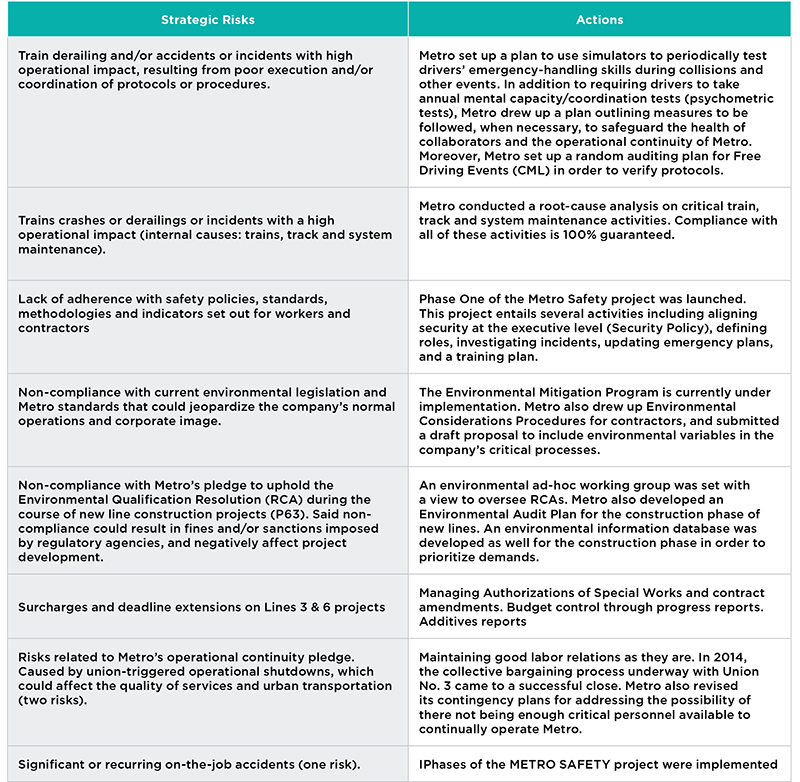
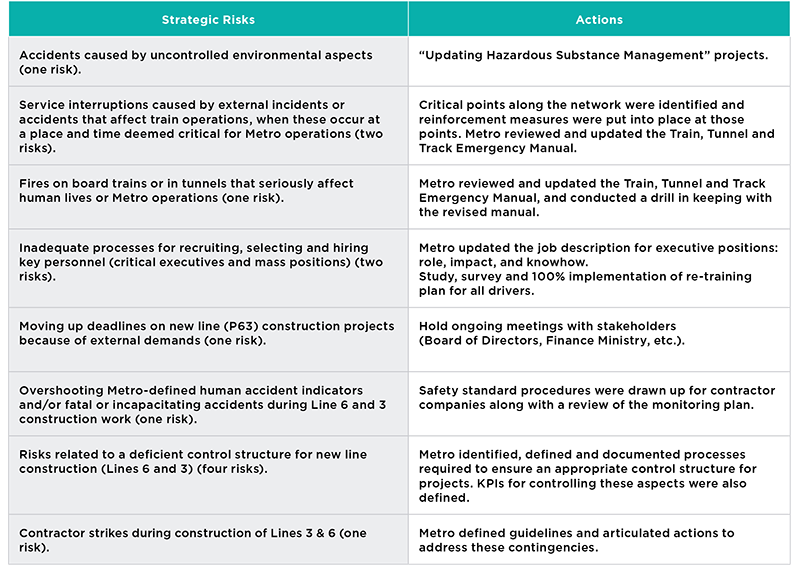
Source: Metro Risk Matrix, Administrative Control and Planning Management

FINANCIAL BALANCE
Financial Administration
Metro is a state-owned company that finances its own operations and a third of its new lines and expansions. The company must constantly safeguard its financial sustainability in order to cover its operational and financial costs and replenish its assets.
Passenger transportation accounted for 80% of the company’s total revenue in 2014. On January 1st, 2014, Metro raised rush hour fares by $30 to finance the air conditioning project. This far increase was enshrined under an Agreement entered into with the Ministry of Transportation and Telecommunications on June 26th, 2013.
It is worth noting that the fare Metro receives as income is different from the far paid by each passenger transported. Although fares paid by customers in December 2014 were $700 during peak hours, $640 during intermediate hours and $590 in off-peak hours, on average, in December 2014 the company took in a technical fare of $349.25 per passenger.
The purpose of the technical fare is to cover company costs, which consist of operational costs, the cost of replenishing assets and paying for debt, over a 40-year period. This fare is updated monthly by a polynomial that takes into consideration the various items making up the Company’s long-term cost structure (CPI, Dollar, Euro, and the price of power and energy).
[G4-EC4] Metro is one of the few underground trains in the world that finances its own operations, while also contributing a third of the funding for new projects and expansions. The other two thirds are financed through investment projects, e.g., Metro received a total of MM $189.739 in fiscal contributions in 2014.
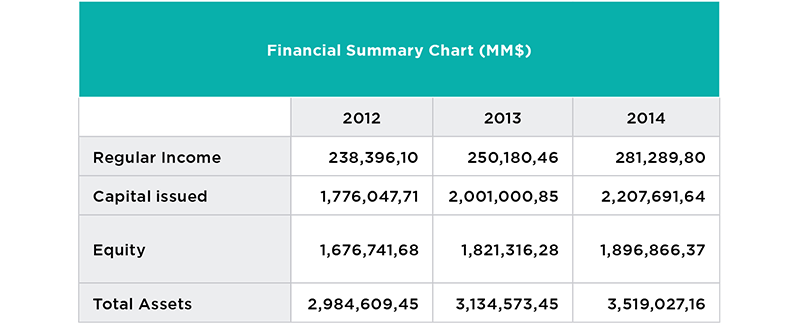
Investment Plans
Metro currently has US$ 3.322 million in investment projects under way, the bulk of which (US$ 2.758 million) corresponds to construction on Lines 3 & 6 while a lesser amount (US$ 564 million) has been earmarked for network improvements.
The company also allocates significant funds to investment studies and projects related to network expansions, system maintenance and infrastructure improvements. Investments in expansion projects are primarily aimed at consolidating Metro’s position as a main artery in the capital city’s public mass transit system, while infrastructure maintenance and improvement investments aim to provide riders with better quality services, safer more stable operations, general facility upkeep, and updating and replenishing systems and equipment so that we may provide our customers with a top-notch service.
Regarding funding sources, in 2014 infrastructure and equipment replenishing and improvement investments were financed by operational revenues and capital contributions. Investments slated for network expansion projects overall—equipment imports—are financed by Metro through borrowing, which the company repays through increases in the technical fare received by Metro. However, domestic equipment investments that cover infrastructure, civil works and other expenses, including import taxes and tariffs on imported goods, are funded through fiscal contributions that are later capitalized.
Metro’s Participation in the International Financial Market
With a view to financing construction on Lines 3 & 6 and other network improvements, in February 2014 Metro issued its first bond on the New York Stock Exchange for a sum of US$500 million. Proceeds were used to finance network improvements, replacing the oldest trains in the fleet with new ones, and installing AC on the rest of the Line 1 cars, along with other projects. This venture has provided Metro with a new option to finance its future projects.
In December 2014, Metro entered into a US$800-million loan with BNP Paribas and Sumitomo Mitsui as agents—the biggest bank agreement ever in the history of the company. This loan will be used to finance civil works, supplies and other expenses related to Metro’s network expansion projects. The BNP Paribas credit will be earmarked for equipment, rolling stock and other expenses incurred during expansion projects.
It is worth noting that the company had to go through a very stringent due diligence in order to obtain credit on the international market. This process entailed conducting a sustainability analysis on the company regarding issues pertaining to communities, the environment and corporate social responsibility.
Income and Expenditures (Economic Value Generated and Distributed)
[G4-EC1] Metro generated an additional 15% in income in 2014 compared to 2013, recording an increase from MM$261,454 to MM$300,542, as a result of a 12.4% bump in revenue from the company’s regular activities. Interest income and other revenues also contributed to the company’s coffers but to a lesser extent.
With regard to outlays, compared to 2013, the greatest expense was booked under operating costs which experienced a 35.1% increase primarily due to higher energy costs, resulting in MM$ 44,288 in overhead and maintenance. Additionally, Metro spent MM$9,000 less on the reinvestment budget item.
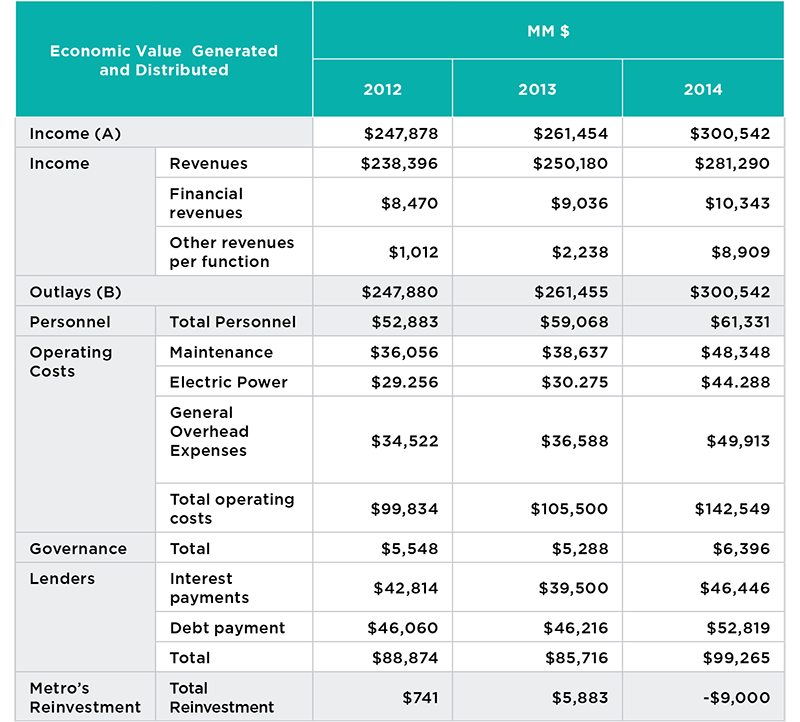

NON-FARE BUSINESS
Non-fare businesses are an important part of Metro’s revenue, amounting to 20% of the company’s 2014 income. The Business Development Department is responsible for managing current business opportunities and seeking out new ones for the medium and long term.
In addition to providing the company with fi nancial support, non-fare businesses benefi t communities as well. Their positive impact is three-fold, i.e., they foster inclusion, provide value-added services, and create a sense of belonging for the Metro brand in the community.
SHOW GRAPH

The main non-fare business are:
Telecommunications: inside coverage on trains and at stations and outside coverage through antennas installed on property and infrastructure and a fiber optics network.
Real estate: office and land leases, and third-party connections.
Advertising: at stations and on trains (JCDecaux), SubTV and external advertising.
Services: ATMs, vending machines, public phones, and mobile services Retail: mini-markets, shops, services, restaurants, bakeries, and telephone services.
Inter-modal Services: irevenues from departures and leases.
Consulting Services: international consulting.
Retail is Metro’s largest non-fare business with a total of 340 shops and modules throughout the entire system.
In terms of consulting work carried out in 2014, Metro’s income coming from this item jumped 127% in 2014 compared to 2013. Metro provided consulting services to a handful of Latin American metros (Argentina, Brazil, Peru and Panama), primarily regarding design issues and new line construction.
As part of its pledge to non-fare business customers, Metro assesses their satisfaction on a monthly basis in order to identify areas where both parties can make improvements and contribute to their business success.
In September 2013, Metro took over the administration of the bip! Card loading system. Metro’s Sales Channel Department is in charge of making, distributing and selling the card.
COLLABORATORS & SUPPLIERS
PEOPLE MANAGEMENT
METROSAFETY
PROFESSIONAL DEVELOPMENT
QUALITY OF LIFE
LABOR RELATIONS
SUPPLIER MANAGEMENT

PEOPLE MANAGEMENT
[DMA] Metro is strongly committed to its workers whom it recognizes as one of the key components in its ability to meet its goals. This is made clear in Metro’s Sustainability Policy in which the company pledges to “conduct Metro’s work with the highest health and safety standards, thereby fostering actions that improve the quality of life of our collaborators.”
Human Resources is responsible for managing Metro employees and contractors.
One of Metro’s interesting corporate strategic projects benefiting workers is its Improving Physical Space project.
In 2015, Metro plans on focusing its efforts on Organizational Development, which will include activities related to knowledge management, education, training and talent management. The primary goal of this endeavor is to align human resources management with the company’s needs and thereby foster a working environment that will aid the company in successfully taking on the challenges left in the wake of 2014.
Metro has an active union life that can be seen in the fluid communication by and between the various organizations. This is clearly exemplified when parties reach agreements on the workday and other issues of common interest. Metro’s unwavering compliance with labor law makes for stable relations with its workers.
Our collaborators
[G4-10] In 2014, Metro increased its staff by 2. 8% for a total of 3,630 collaborators, broken down into 76.6% men and 23.4% women.
SHOW GRAPH

Metro aims to provide its collaborators with a stable environment. Accordingly, a large percentage of its workers are full-time employees with open-ended contracts (97% in 2014)
Collaborators broken down by Work Day and Contract Type
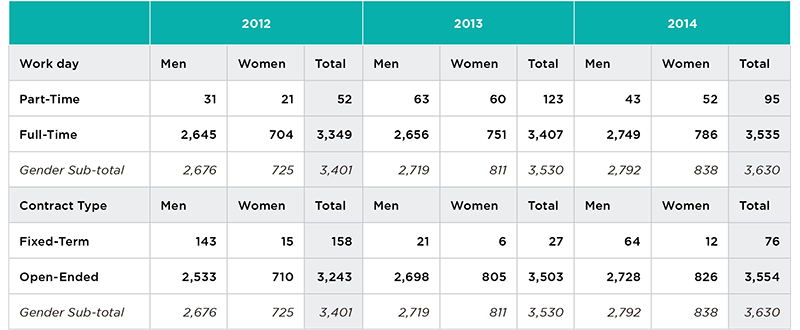
[[G4-LA12] Regarding gender diversity, in 2014 there was an increase in the number of women in executive-level positions compared to 2013 (14 to 21). Moreover, there was a slight rise in the number of women working in maintenance positions as well.
“Station Staff” continues to be the highest-ranking category in terms of number of female workers, with a total of 229.
Collaborators by staff category.
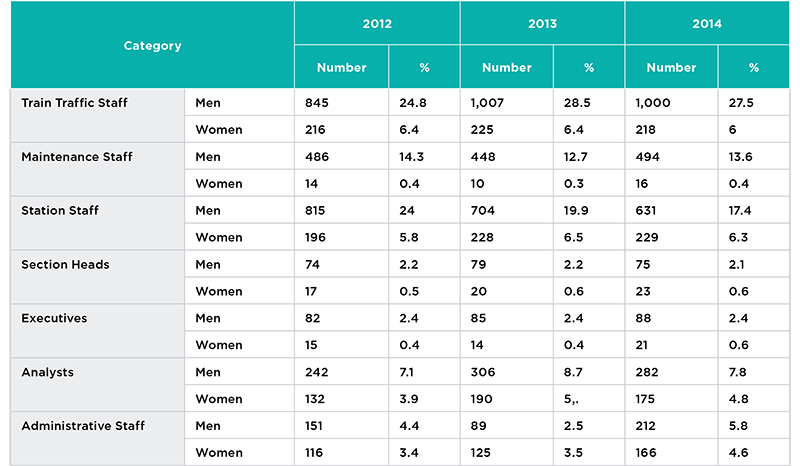
[G4-LA12] Age-group diversity remained the same from one year to the next with 57% of all collaborators between the ages of 30 and 50. The total number of collaborators under the age of 30 dropped slightly, the 30-50 age group did not undergo any changes, and the over 50 group increased moderately.
SHOW GRAPH

Recruiting & Compensation
Metro guarantees equal opportunity and rejects any type of discrimination whatsoever, as stated under its Code of Ethics.
The recruiting process is an example of this pledge. There aren’t any differences drawn between applicants during this process except for the job skills required.
In 2014, Metro hired 199 new collaborators and recorded a 3.99% hiring rate. Regarding compensation, we have a Compensation Policy that takes into consideration work experience, maturity, and performance when determining collaborators pay band and specifying compensations, without foregoing outside competition and in-house equity.
Gender is not considered a variable when deciding on pay rate. The company compensates workers for their performance and contribution with monetary and non-monetary compensation (benefits and recognition).
[G4-LA13] Female-to-Male Base Pay Ratio
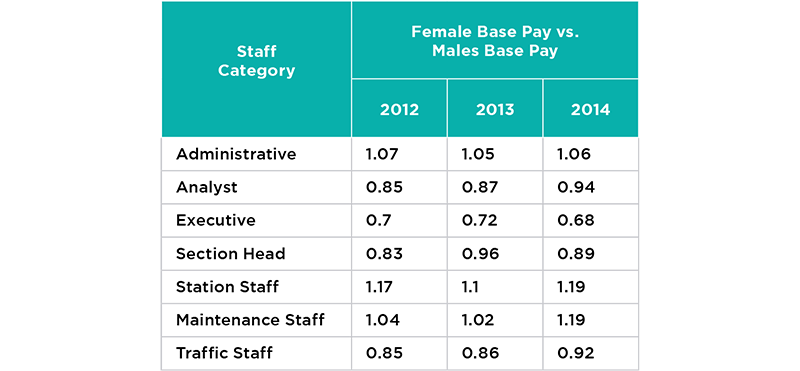
[G4-EC5] Compared to Chile’s national minimum wage—which was equal to 225,000 CLP in December 2014—the lowest wages paid to men and women at Metro were 1.24 and 1.34 times greater than the national minimum wage, respectively. Furthermore, Metro workers with open-ended contracts receive an operational bonus, which increases their monthly taxable income.
Metro’s Minimum wage vs. National Minimum Wage

Turnover
[G4-LA1] During the period, 266 individuals left the company, resulting in a turnover rate of 7.33%. This is slightly greater than the year before.
Turnover Rate

Turnover: number of workers who have left the organization vs. total number of workers.
Fifty-six percent (56%) of the workers who left the company in 2014 were from the 30-50 age group, followed by 36% from the under 30 group
Resignation by Age Group

COLLABORATORS & SUPPLIERS
PEOPLE MANAGEMENT
METROSAFETY
PROFESSIONAL DEVELOPMENT
QUALITY OF LIFE
LABOR RELATIONS
SUPPLIER MANAGEMENT

METROSAFETY
Through its Safety Policy Metro works toward fostering the value of safety across the entire organization, including every process undertaken by the company involving its workers, contractors and customers.
Health and safety are a corporate priority as well as a strategic concern addressed from the top by Metro’s Board of Directors. In order to adopt a leadership stance on these matters and promote them throughout the company, Metro’s CEO presides over a monthly meeting of the Managing Committee where members discuss health and safety administration, focusing primarily on the highlights of the METROSAFETY program under implementation, relevant incidents, and the status of employee, contractor and customer accident rates.
The Operational Safety and Emergency Response Unit is in charge of the METROSAFETY system. This unit is staffed by risk prevention experts and engineers who worked on Metro’s train lines, maintenance area, and new line projects. Their goal is to ensure the organization-wide penetration of operational safety.
METROSAFETY (an integrated safety system) and associated programs provide the company with a means to manage planning, execution and verification of safety aspects in addition to weaving safety-related continuous improvement actions into the company’s activities.
METROSAFETY is tailor-made to address the company’s specific needs and context and consists of 22 safety management items that, as a whole, provide exhaustive and systematic coverage of all aspects related to Metro’s operations and services. Given its broad scope, METROSAFETY was designed to be rolled out in three separate phases over the 2013-2016 period, as follows:
SHOW GRAPH

The first phase was completed during the second half of 2014. The goal of the first phase or “standardization” was to close the gaps affecting the company’s priority concerns and ensure regulatory and legal compliance. Moreover, work began on the second phase or “development,” which will focus on managing preventively and standardizing practices.
System rollout included several programs pointed at the administrative side of different areas throughout the organization with area managers taking on the role of safety management.
METROSAFETY entails gradually setting up these safety-related programs companywide. The following are the priority areas chosen for 2014:
Operations and Services Department: programs seeking to decrease and control the accident rate. Activities began in the various Line Sub-Divisions, specifically in train and service units, and Safety Committees were set up to take the lead on the matter.
Maintenance Department: programs seeking to control the accident rate and manage risks inherent to maintenance tasks. That is why the company decided to begin with two maintenance units—trains and stations—adding programs to Metro’s various workshops.
Project Development Department: programs seeking to ensure regulatory and legal compliance, control contractor accident rate, and manage the risks related to construction work on Lines 3 & 6. That is why all actions were focused on program implementation.
METROSAFETY and project contractors: prior to implementing the various programs, the company conducted several training sessions with different levels of company leadership, to with Metro Assistant Managers, Line Heads and Supervisors, Maintenance Heads and Supervisors, Section Heads and Coordinators for the Line 3 and 6 projects, Health and Safety Committee members, and Unions.
Oversight and compliance control actions were set in motion once the programs were completed, all with a view to identifying potential areas of improvement in processes, procedures, training, and other aspects related to the Integrated Safety System.
Safety Committees
[G4-LA5] Metro has 11 Safety Committees that cover all workers (100%) from line operations to maintenance shops, corporate offices and other buildings. Each committee is made up of three principal members and three alternate members representing both workers and the administration. One of the committees was dissolved in 2014 because of changes to the Project Department’s structure.
In 2014 the company held four training sessions on the Integrated Safety System as part of the METROSAFETY program. This training was provided to Safety Committee members with a view to standardizing how the eleven committees manage and coordinate safety actions. Committee chairs met in October to review Metro’s riskprevention management results by area.
[G4-LA6] In terms of occupational safety statistics as applied to Metro workers, the table below illustrates a stable trend for accidents occurred during the 2013-2014 period. However, there was a slight drop in the number of days lost due of accidents, not to mention a lower severity rate for the Accident Rate.
Metro workers occupational health and safety figures.
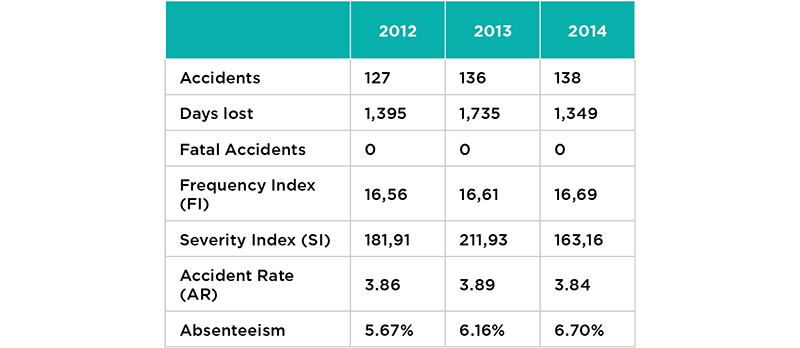
FI = (# of LT/MH accidents for the period) x 1,000,000
SI = (# of days lost bc of LT accidents/Hrs. for the period) x 1,000,000
AR = (# of LT accidents/average staff for the period) x 100
Occupational safety is a priority for Metro, and not just in regards to its own workers but also for contractors hired to build the new lines.
Metro’s tenders explicitly define the safety requirements that must be met by all contractors. Once tender contracts are awarded, the winning bidder receives a copy of Special Contractor Regulations.
Given the construction work model, there are several bodies set up to provide control and oversight for risks associated with field activities. The work schedule outlined by Metro is set up so that contractors in charge of construction works are responsible for risk control, while contractors in charge of Technical Work Inspections (TWI) must provide oversight for all activities included under the construction schedule and ensure that they are carried out. Finally, Metro conducts audits on the entire system as the organization responsible for ensuring adequate TWI oversight of the construction company.
In 2014, Metro set up technical working committees with contractors showing the highest accident rates and the respective TWIs assigned to supervising their work. The purpose of this initiative was to update risk matrixes and draft new work schedules according to the real situation in the field. As a result, the company was able to put more appropriate controls in place for hazards identified.
Contractor occupational health and safety figures

FI = (# of LT/MH accidents for the period) x 1,000,000
SI = (# of days lost bc of LT accidents/Hrs. for the period) x 1,000,000
AR = (# of LT accidents/average staff for the period) x 100
[G4-LA7] Metro makes an effort to provide adequate occupational health conditions, which is something the company also addresses under METROSAFETY, its Integrated Safety System. In 2014, the company worked on developing an analysis and evaluation of risks that could give rise to occupational illnesses. In addition, the company used the results to better manage the risks identified in this regard.
COLLABORATORS & SUPPLIERS
PEOPLE MANAGEMENT
METROSAFETY
PROFESSIONAL DEVELOPMENT
QUALITY OF LIFE
LABOR RELATIONS
SUPPLIER MANAGEMENT

PROFESSIONAL DEVELOPMENT
Training & Education
[G4-LA9] In 2014, the company put in a total of 120,246* hours of training, with an average of 33 hours per collaborator, compared to 162,175 hours and an average of 46 hours per collaborator in 2013. For the first time we are able to submit a breakdown of average training hours by gender: 36 annual hours of training for men and 22 for women.
In keeping with its pledge to provide users with quality service, in 2014 Metro security guards logged the highest average of training hours (57.5 ), followed by maintenance technicians, assistant managers and analysts.
Average number of training hours per professional category
SHOW GRAPH

[G4-LA10] Metro’s formal training programs are broken down into two large groups, i.e., Corporate Training and Operations Training.
Corporate Training Programs
Annual training plan for managers: this plan focuses on activities aimed at closing functional skill gaps, which are determined through a training needs survey.
In 2014, the company carried out 255 activities during which 3,343 workers participated in a total of 119,977 man-hours of training provided to Metro’s eleven corporate departments.
Corporate Integration: Metro redesigned and launched its new Corporate Integration Program consisting of an induction process that seeks to better integrate newcomers and instill personnel with company culture, mission and identity.
The new format entails a more participatory and experience-based methodology aimed at bringing participants closer to one another and thereby strengthening their sense of belonging with the organization and integration.
Throughout the year the company carried out 20 integration activities with 272 new workers.
Operations Training Programs
Operations training programs are two-pronged:
- Job Readying (drivers, private security guards, station heads, and supervisors
- Refresher course to keep up the level of knowledge and skills required by workers to meet company goals.
During the period, the company conducted 533 refresher courses for operations personnel, including station heads, intermodal inspectors, and service supervisors. The main goal of these training activities was to bolster managerial tools and communicate information on Subcontracting Regulations, Metro’s Train, Tunnel, Track and Station Emergency Manual, effective communication, and case studies on incidents occurring at our stations, all with a view to discussing best practices and reinforcing procedures.
Likewise, drivers went through refresher courses that addressed issues identified during a gap survey (an on-line assessment conducted through the EDUMETRO training platform). The latter consisted of detecting crosscutting issues that are critical to operations such as signage, maneuvering and breakdown zones, NS-74 technology, in addition to other technologies installed on our trains. Furthermore, 900 drivers received updated training on our Train, Tunnel, Track and Station Emergency Manual.
During the year, the company completed the second stage of implementation of the Service School for internal and external operations personnel. A total of 1,257 individuals participated in the program, which was aimed at building customer service skills, such as empathy and assertiveness, in addition to ensuring that Metro’s Service Strategy is followed correctly during operational practices.
Performance Evaluation
Given the new challenges facing the company, Metro’s Performance Management system is currently under review in order to make room for improvements in the 2015 version.
All individuals meeting seniority requirements and the absenteeism rate undergo a formal performance evaluation and receive feedback on their strengths, areas of improvement, and development opportunities.
Metro continues to employ the Performance Evaluation as a merit-based management tool thereby providing personnel with opportunities to apply to in-house positions, raises, courses, scholarships, etc. In 2014, the number of individuals reviewed continued on an upward swing.
[G4-LA11] Collaborators undergoing Performance Evaluations

COLLABORATORS & SUPPLIERS
PEOPLE MANAGEMENT
METROSAFETY
PROFESSIONAL DEVELOPMENT
QUALITY OF LIFE
LABOR RELATIONS
SUPPLIER MANAGEMENT

QUALITY OF LIFE AND WORKING ENVIRONMENT
Environment
In 2014, the company conducted a survey to assess workers’ perception of the working environment, and also held focus groups to study certain issues in depth. Working groups were then set up by departments in order to identify challenges and opportunities, in addition to agreeing on problem-solving strategies.
This year Local Working Environment Committees were set up by collaborators from each department. The roles of these committees is to match corporate solutions with local requirements in order to come up with solutions that truly meet each team’s individual needs.
In order to ensure that the Local Committees work well, several meetings and training sessions were held with committee leaders, who received the necessary tools to perform the task of matching crosscutting solutions to local needs.
QUALITY OF LIFE
[G4-LA2] Metro offers a variety of social benefits that aim to address the various circumstances and needs of collaborators with open-ended contracts. The company is fully convinced that a person’s quality of life has a direct impact on its development. As a result, the company continues to work hard to provide better benefits and wider coverage.
Wellness Fund: the purpose of this fund is to improve the living conditions of workers and their families by way of several benefits including health-care services, and medical and social grants. In 2014, 97% (or 3,455 collaborators) of Metro workers with open-ended contracts were enrolled as fund beneficiaries, while only 84% were signed up in 2013.
The fund is funded through member and company contributions at a ratio of one to five. In 2014, the company bolstered company health benefits by raising the limit on reimbursements, e.g., it doubled the dental health benefit. Moreover, special mother’s milk benefits were added to the ranks, reimbursement for physical therapy and speech therapy treatments were raised, and the special services policy coverage was expanded to include children up until the age of 25 and those whose cannot continue their studies due to illness.
Drug and Alcohol Policy and Program: we updated our Drug and Alcohol Policy throughout 2014 and provided related training to 43 managers and supervisors.
Social Services: the Quality of Life area founded a program entitled “Más cerca de ti” (Closer to you). This program is a communications and support network set up in order to provide collaborators with easier access to benefits. In 2014, 618 collaborators received social services and 101 field visits were conducted.
Moreover, 35 workshops were held and the first meeting with operations supervisors was held in order to set up a network for getting benefit-related information out to workers.
Social Bonuses/Benefits:
- “Metro te Acompaña”: includes bonuses for marriage, birth of a child, and death of a spouse, children and parents. In 2014, 322 workers received benefits under this program (8.9% of the membership).
- Education Bonus for workers’ children and workers who study: benefits ranging from pre-school to higher education bonus. In 2014, 1,420 workers received this support (39% of the membership).
- Health Care Benefits (drugstore, dental, optical, hospitalizations, etc.) and social benefits (emergency support, housing and funeral arrangements): 2,084 workers or 60% of program memberships benefited from this category.
“Metrovida” Health Program: in 2014 the company decided to reinforce this program by adding preventive health care initiatives such as the flu vaccination campaign for 1,366 workers and other preventive health care initiatives such as the “I prefer knowing I am healthy rather than thinking I am” campaign under which 740 workers received care. Cost-free medical and nutritional services were also provided to 219 collaborators.
Additionally, the company held a “Health Fair” to spread information on health care programs and benefits provided under the various company initiatives.
Recreation and Sports Program: In 2014 we launched several initiatives aimed at improving the quality of life of our workers and their families.
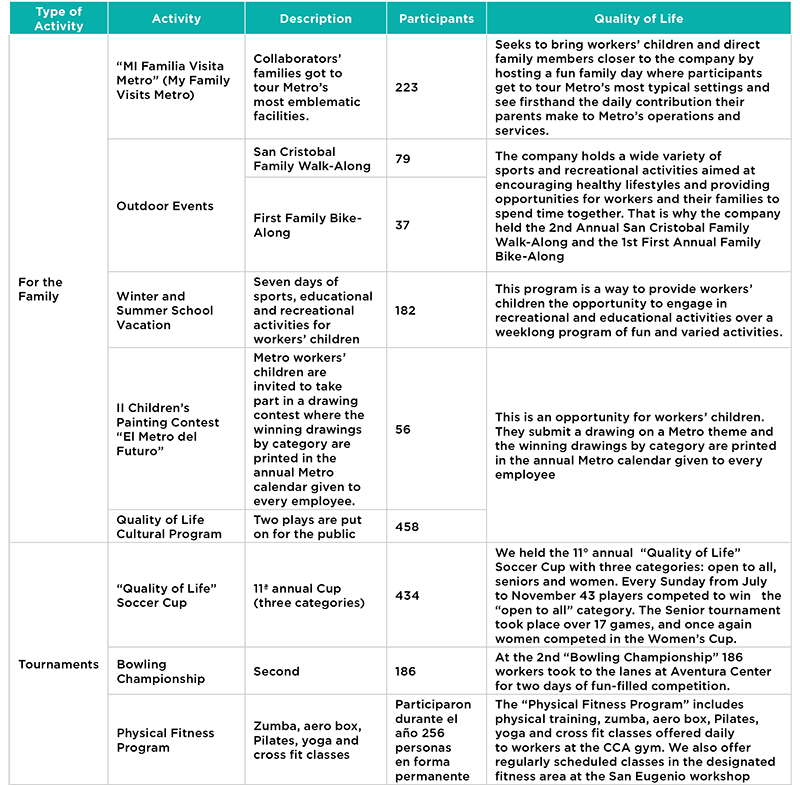
Protection for Motherhood
Metro is concerned with providing a family-friendly workplace. Accordingly, the company and the Federation of Unions joined efforts to draw up a Maternity Policy that outlines a series of protective maternity benefits, beyond legal requirements, targeting pregnant workers and working mothers with children under the age of two.
Benefits include an allowance for daycare, shorter working days during the post-natal period, and two hours off for feeding their babies, which is one hour more than the legal limit and provides mothers with enough time to get to where their children are located. Pregnant corporate employees who wear a uniform also receive maternity wear and a monthly half-day leave to bring their children to well baby doctor’s appointments. Furthermore, special considerations are provided for women working in train service operations, based on the nature of their work.
[G4-LA3] During the 2014 period, 42 women took advantage of their maternity leave and all of them stayed in their jobs after a one-year period.
COLLABORATORS & SUPPLIERS
PEOPLE MANAGEMENT
METROSAFETY
PROFESSIONAL DEVELOPMENT
QUALITY OF LIFE
LABOR RELATIONS
SUPPLIER MANAGEMENT

LABOR RELATIONS
[G4-HR4] Company-Union relations are crucial to Metro. As a result, the company holds monthly meetings with each union and the Federation, in addition to separate meetings with the joint working groups. Communication between the parties is direct and constant either at meetings, through daily interactions or by phone or E-mail.
Freedom to associate is respected to such an extent that in 2014 the security guard union was formed and two driver unions merged into a single organization. As a result of these changes, Metro now has four labor organizations:

In terms of the right to collective bargaining, in 2014 Union No. 3 reached an early agreement as part of its legal right under labor law.
[G4-11] In 2014, 85.5% of Metro workers were members of one of Metro’s four labor unions, resulting in a 3.05% increase in the unionization rate compared to 2013.
It is worth noting that 88% of Metro workers are covered under collective agreements.
SHOW GRAPH

[G4-LA4] Any and all changes to the workday are discussed with union representatives, which is why there is no legally provided time frame for operational changes or creating new positions. Dialogue is the first step and a mutually agreed to effective date is determined. By law, if a specific deadline has been established it is abided by, such as the exceptional working day which was agreed to by labor organizations and the administration and authorized by the Department of Labor Inspection for a four-year period.
[G4-HR6] Metro is known for being an organization that respects labor law, which is why forced labor does not exist. We strive for our workers to adhere to their shift and we make sure breaks are taken. Overtime is voluntary. We reinforce these guidelines through the Code of Ethics.
COLLABORATORS & SUPPLIERS
PEOPLE MANAGEMENT
METROSAFETY
PROFESSIONAL DEVELOPMENT
QUALITY OF LIFE
LABOR RELATIONS
SUPPLIER MANAGEMENT

SUPPLIER MANAGEMENT
[DMA] Metro’s suppliers and contractors are a very important link in our value chain, specifically those working in operations and maintenance and on Line 3 & 6 construction.
Metro has an Acquisitions Policy that outlines the main criteria and standards for purchasing goods, services and works. The primary goals of the policy consist of ensuring purchasing processes are transparent, resources are used optimally, and Metro personnel working in acquisitions have clear guidelines.
[G4-12] In 2014, Metro had a total of 5,176 suppliers. The main ones are listed below:
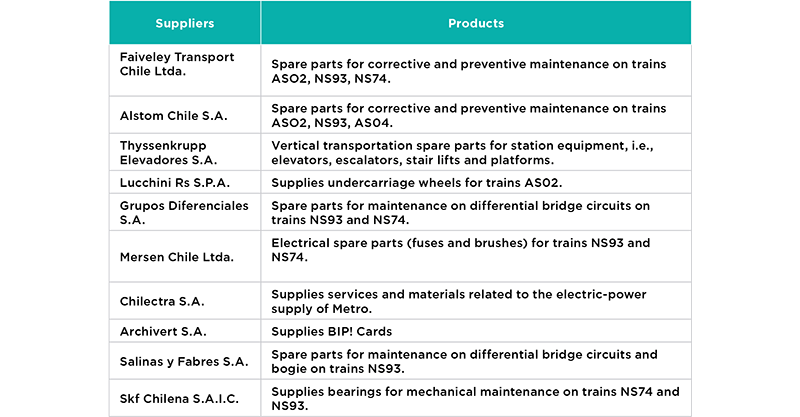
In 2014, Metro worked with 38 key service contractors under its subcontracting system. They are broken down into five categories as follows:

Metro’s supply area is responsible for acquisitions through public bidding. Once suppliers are selected, each individual department handles contract administration depending on the service hired.
In terms of contractors, the HR Outsourcing Department is in charge of managing and overseeing that all contracts issued under the subcontracting system meet legal labor and social security requirements. [G4-LA14] In terms of contractor relations, Metro gives priority to its subsidiary role as the principal company in this relationship and evaluates its contractors on their compliance with labor and social security requirements. To this end, Metro requires all contractors to submit a monthly labor and social-security compliance certificate issued by the Department of Labor (F30-1).
Since August 2014, Metro has been working with a certification company in charge of conducting monthly field inspections and oversight to ensure contractors are meeting legal labor and social-security requirements, working conditions, and workers rights. All observations recorded during inspections are reviewed and classified by the Outsourcing Department and sent to contract administrations fro their follow-up. Monthly reports on contractor compliance are submitted to Metro’s Board of Directors.
Metro has the right to withhold payment when contractors do not comply with labor and/or social security requirements.
In 2014, Metro conducted the 4th Supplier Satisfaction Survey in reference to the bidding process. Twenty-three companies answered the survey and the results were used to identify process improvement opportunities.
[G4-EC9] Supplier and contractor expenses in 2014 increased by 42%, for a total of 574,722 million pesos compared to 404,840 million in 2013.
Domestic and international purchases followed the same trend, with a slight increase in the percentage of international expenses.
SHOW GRAPH


THE COMMUNITY
At present, the socio-political context is marked by an increasingly empowered society that demands greater levels of participation. As a result, communities cry for companies to be managed transparently and responsibly while also being in touch with their surroundings. These circumstances result in citizens demanding to be involved in projects that have an effect on their quality of life.
In this context, in 2013 the company drafted its Community Relations Strategy with a view to “facilitating the transition toward a new stance in which Metro becomes a leading social actor in Santiago society in terms of integrating city life and the sustainable coexistence of city residents, without compromising the quality service and technical expertise for which Metro is known.”
The company’s Sustainability Policy is firmly set within this strategy, and one of its primary prongs is the community and its pledge to “adding to the quality of life of the communities linked to our operations and projects, in addition to contributing to society through culture, social projects and urban services.”
The Community Relations Strategy contains specific objectives related to: getting to know important stakeholders, preventing and mitigating social and environmental impacts and their conflicts, creating and maintaining proactive and ongoing ties with social and municipal organizations, as well as creating organizational capacity and sustaining the continuous improvement process within the company.
Keys Aspects of the Community Relations Strategy (CRS)
In 2014, the company consolidated its Community Relations Area with a multidisciplinary team of professionals who address managerial aspects pertaining to the construction of new lines and existing lines currently under operation.
The focus was on consolidating procedures for managing work within communities located in areas of influence of Metro operations and new lines construction sites. Moreover, administrative indicators were set and periodic reports on working with the community work must be issued. This issue was also placed on the planning agenda for operations (refurbishing stations, workshops, depots, and stations surrounding) and projects (location of shafts, ventilation shafts, etc.).
The strategy will continue to be implemented throughout 2015 followed by an evaluation and consolidation phase scheduled for the following year.

Proactive and Ongoing Ties
[G4-SO1] In 2014, Metro set several corporate goals, one of which was to increase the total number of community activities undertaken. The company exceeded this goal by 19% by holding a total of 136 activities in the area of influence of its operations and new line construction sites.
These activities included: 48 community meetings (accounting for 35% of all activities) with a total of 444 participants. Residents from neighborhoods located near the construction sites of the new lines 3 and 6 attended these meetings along with community association representatives, building managers and other. The purpose of these meetings was to report to the community on matters of local interest such as noise mitigation, local construction inconveniences, complaint management, and provide information on topics of community interest. There were also operationsrelated meetings held with communities in reference to different projects.
Moreover, the company held community visits to Metro’s operational facilities and Line 3 and 6 construction sites. Regarding visits to new line project sites, this is one way Metro keeps its stakeholders informed, and creates awareness among them as to benefits provided by these projects to the common good. The company also leverages these opportunities to report on construction progress and talk about construction methods.
Neighbors, university students, authorities and municipal technical teams visited the shafts of future lines 3 and 6. Other institutions also took part in these activities as well, i.e., the Coyhaique Chapter of the Chilean Chamber of Construction, Universidad Austral, Valparaíso Catholic University, Santiago Catholic University, DUOC’s Maipú and Puente Alto campuses, and others.
Community activities carried out in 2014
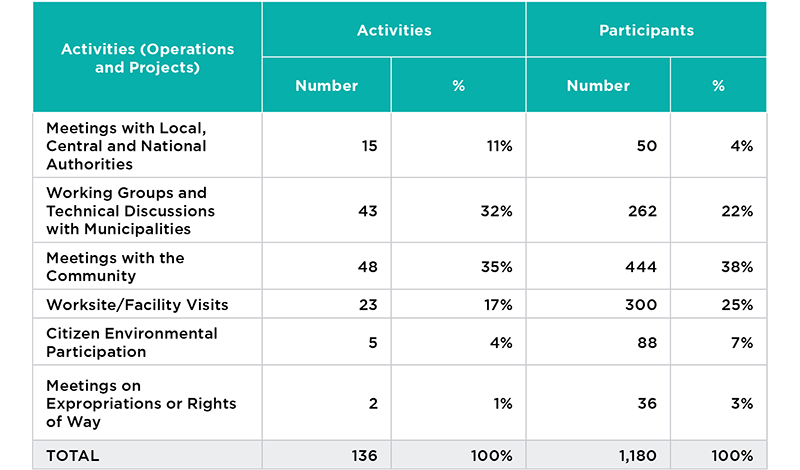
SHOW GRAPH

A positive milestone in 2014 pertaining to construction works on lines 6 and 3 was when Metro did good on its commitment to the Providencia community by closing down Suecia Street for only two months (January and February). The company was able to keep its promise thanks to the bypass it built at the end of 2013 that shortened the street closing time from six to four months, thereby minimizing disturbances and impact on local merchants. Prior to closing off the street Metro met with local merchants to apprise them of the various stages of construction, set up ongoing channels of communication, and provide support for local information strategies (flyers, pamphlets, monitors, social media reports, meetings and complaint management).
This is merely one example of how Metro has worked diligently on providing the community with early, clear and timely information on the impact of construction on lines 3 and 6 as it evolves.
The “Good Neighbor” Plan
En el ámbito de la operación, durante el año 2014 se inició la elaboración del Plan Buen Regarding operations, in 2014 the company launched the Good Neighbor Plan along with an in-house survey to gather information, and a few pilot initiatives. One of these was the first-ever collective ceramic mosaic project undertaken by a nearby school in the community surrounding the Monte Tabor Station.
There were other initiatives carried out under the plan such as the land loan and use program for nearby land belonging to Metro corresponding to tunnel ventilations and space reserved for additional future access points.
A few 2014 examples of the above are as follows:
- Line 4 Ventilation Shaft located at the intersection of A. Vespucio and Fco. Villagra, in Ñuñoa.This area was lent to the Municipalidad of Ñuñoa and made into a park that significantly improved the local area.
- Plaza Libertad, Line 5, located at the corner of Catedral and Libertad, Santiago; An area reserved for building the main access point for the future station bearing the same name. This space was lent to the Santiago Municipality for community use and small recycling containers were set up there.
Regarding the line 3 and 6 construction project, in 2014 the company began assessing the feasibility of including the municipality and community in the future station surface design process as a way to evaluate their concerns.
As a result, Metro has been able to better coordinate the involvement of several public bodies and municipal departments in projects with community benefits.

MANAGING COMPLAINTS
[G4-SO11] In 2014, Metro received and managed a total of 340 complaints. Twenty-two (22) of these were related to Metro’s current network operations and 318 were due to construction work on the new lines. About the latter, 130 of them were in connection to Line 3 (41%) and 188 to Line 6 (59%).
Disturbing noise was the main reason, followed by safety issues arising from construction works.
SHOW GRAPH
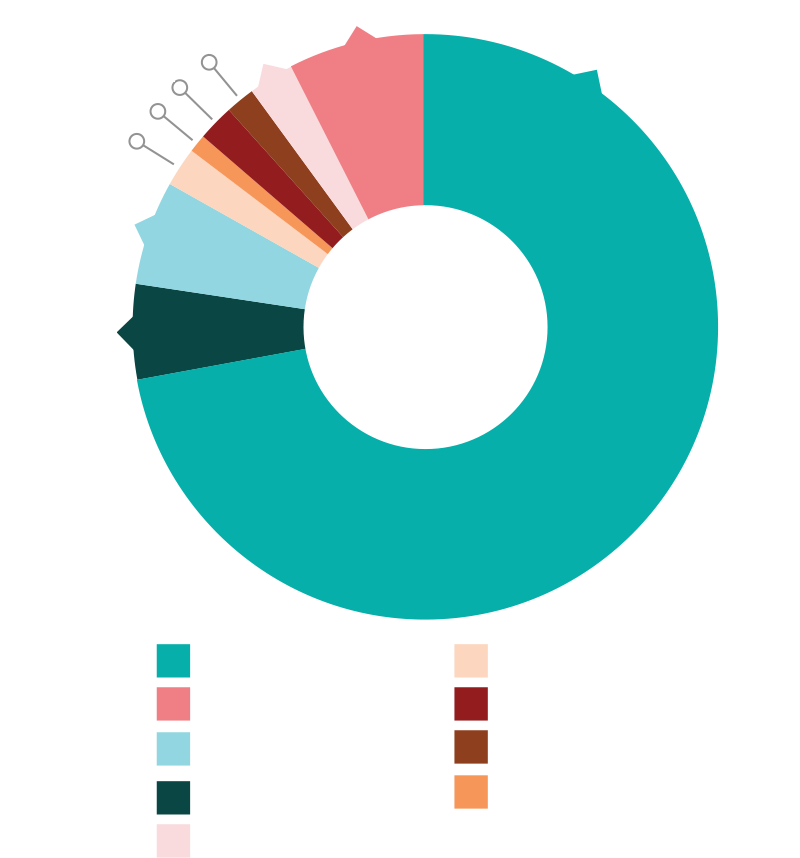
It is worth noting that although 75% of these complaints were lodged in a complaints log available to the community at each construction site, through E-mail, regular mail and direct mail at the Community Relations department, our protocol dictates that all complaints be immediately relayed to the Customer Service Office (OAC) to be duly recorded in our system. In addition to a formal response from the OAC, the Community Relations team. stays in constant contact with those involved in order to conduct a proper follow up and monitor the situation.
[G4-SO2] As for operations, most of the operations-related complaints are due to noise and vibration. Metro is working on mitigating these issues at critical locations identified through our Environmental Mitigation Program.
Regarding construction of Lines 3 and 6, 67% of these complaints are due to disturbing noise. In 2014, the company implemented a complaints management system in order to gain access to unique corporate data regarding complaints filed. The objective is to align our procedures with existing mechanisms and manage all the information centrally at the Customer Service Office (OAC).
Community Complaints Protocol for Line 3 and 6 Projects
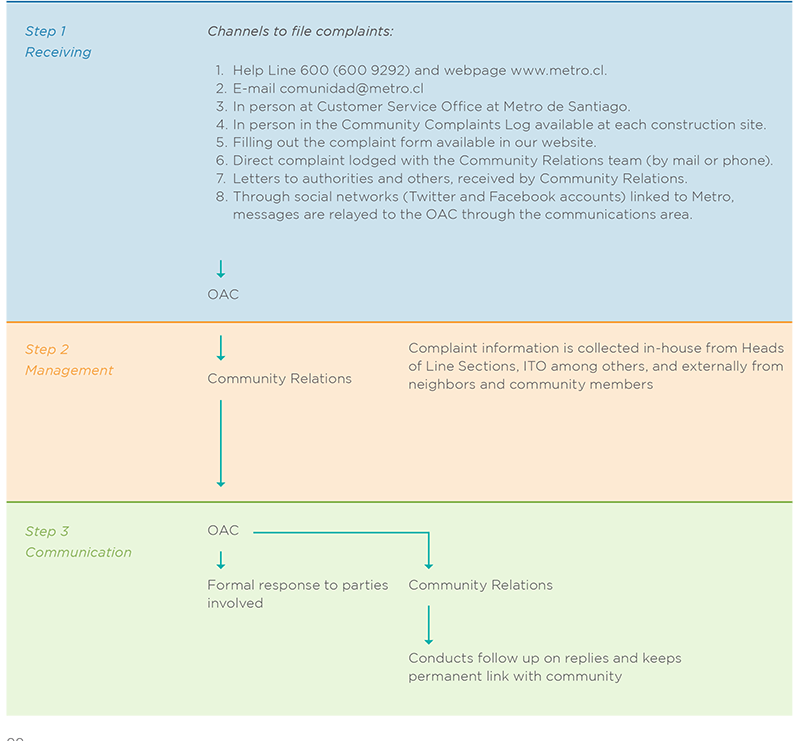

CULTURAL CONTRIBUTION
Since its very beginning, more than 20 years ago, Corporación Cultural MetroArte has focused its efforts on supporting culture and the arts through public art, fostering reading and interventions in public spaces.
Public Art
MetroArte projects are permanent, large format art installations funded by private corporations under the Cultural Donations Act. Our underground network currently hosts 33 public works, which breathe life into such a socially-relevant artistic initiatives given its public breadth in the City of Santiago.
There weren’t new works inaugurated in 2014 since our activities were focused on coordinating the station design efforts for the new Lines 3 and 6, which entailed seeking a relevant neighborhood identity for each station based on location. Regarding Line 6, our efforts are focused on stations Franklin, Cerrillos, Ñuñoa, Estadio Nacional and Inés de Suarez; and for Line 3, on stations Plaza Egaña, Irarrázaval, Cal y Canto, Plaza de Armas, Diagonal Oriente, Plaza Chacabuco and Libertadores. We have already determined the areas, materials and construction themes for these stations which will serve as the basis for their 2015 tender.
Participatory Murals:
This project allows individuals, groups and community organizations to conduct interventions on the walls of specific Metro stations, and create emotional bonds and a sense of belonging with the physical space. The company choses the stations and exterior walls, which are set aside for, use by municipal community organizations.
This initiative can be defined as an artistic-social project that is set up so that Metro stations take root in the local communities. It is a participatory project for citizens because it involves neighboring communities in coordination with official organizations operating in those territories.
“Participatory Murals” are divided into two categories:
Permanent outdoor: This category, for example, involves the exterior of the Line 4 viaduct in the Puente Alto district and Paso Matta in the Santiago District.

Temporary indoor: a few examples worth highlighting in this category are a few projects undertaken as part of an agreement with the Justice Department and its agencies. In keeping with such agreement inmates, senior citizens and at-risk children have painted more than 12 murals.

Promoting Reading
Metro de Santiago Network, thereby making this system the number one public library in Chile with the highest book borrowing rate. The 2014 figure, however, is lower than last year because two of the most popular sites at the Los Héroes and Baquedano stations were closed for renovations. This year the company made progress on planning the future sites for Lines 3 and 6.
For 13 years in a row Metro, Plagio and Minera Escondida have organized the “Santiago en 100 Palabras” (“Santiago in a 100 words”) literary competition. A total of 45,440 stories were received, making it the most widespread literary contest in Chile. Moreover, this initiative has become an example successfully followed and replicated by other countries such as Mexico and Hungary.
Public Space Intervention Programs
In 2014 we renewed our efforts to provide Santiago residents access to a variety of artistic and cultural expressions as they walk through our network. “Música de estación” (“Music at the station”) and “Teatro de estación” (“Theater at the station”) are two of the highlights under this initiative, pleasantly surprising our users with performances by: UPA, Leo Rey, Nano Stern, Nicole, Manuel García, among others, and La Llave Maestra Theater Company with plays such as “Bestiario” and “Delirios de Papel”. A total of 36 activities were carried out during this year at different Metro stations.
SHOW GRAPH


SUPPORTING SOCIAL INITIATIVES
As a state-owned company Metro is not allowed to grant direct economic donations to social initiatives. Instead of the latter, the company channels its support to a variety of organizations by making space and facilities available to them to promote their causes and activities.
In 2014 more than 460 individual advertising spaces were made available, including panels, advertising panels, trains and door sides. The organizations that benefited from this were: Hogar de Cristo, Coanil, Techo, CODENI, Protectora de la Infancia, Good Neighbors, Mi parque, Teletón, Banigualdad, Fundación Paréntesis, Fundación para la Superación de la Pobreza, Fundación Descúbreme, Fundación Leche para Haití, América Solidaria, Fundación Gantz, Belén Educa, Greenpeace, Fundación Valoriza, Fundación Opción, Unicef, Sochicar ( Sociedad Chilena de Cardiología), and María Ayuda.
Metro workers also carried out a number of activities to benefit several social groups.
MetroInforma
MetroInforma is a service managed by the Commercial and Corporate Affairs Department providing a number of organizations with space so they can advertise cultural or social contributions. All events and activities advertised must necessarily be massive and not-for-profit. To this end, Metro has installed informational billboards at its 108 stations. These are updated monthly in order to provide foundations, corporations, public entities, museums, universities, cultural centers, theater schools, leagues, educational institutions, and other organizations more opportunities to disseminate their activities.
In 2014 more than an average of 40 institutions requested space every month in the Metroinforma billboards for their posters to be displayed at our stations.
After conducting a review on requests for space to advertise events and activities from January through April 2014, the following organizations and institutions were accounted for:
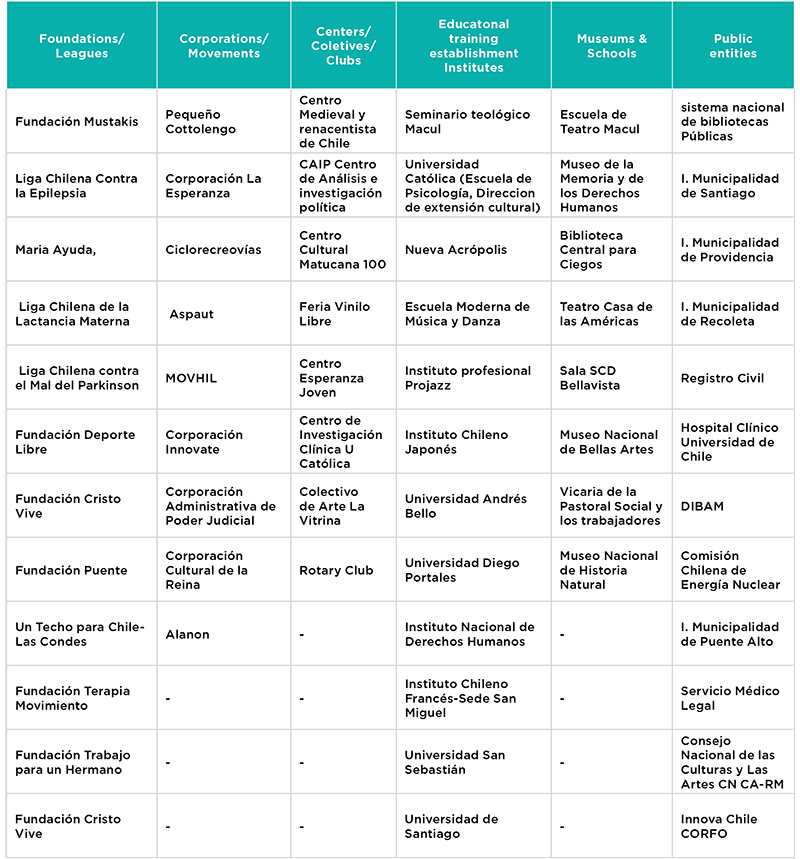
Additionally, a number of organizations are allowed to conduct fundraisers inside the stations. The majority of these activities take place between the months of April and August. In 2014 Metro provided a variety of organizations access to these spaces, such as: Maria Ayuda, Liga Chilena de la Lactancia Materna, Liga Chilena contra el Mal del Parkinson, Pequeño Cottolengo, Aspaut, Biblioteca Central para Ciegos, Corporación La Esperanza, Niño y Patria, and Coaniquem.
Supporting the 2014 Teletón
Teletón is a charity that mobilizes most of Metro’s workforce. In order to facilitate and centralize its initiatives, 70 ambassadors are appointed to act as liaisons with our 3,500 plus workers and over 5,500 external collaborators who also participate in the various activities.
As a state-owned company, Metro is not allowed to make donations. Its workers, however, are allowed to, so they do. This is an incentive for our work teams to organize flea markets, raffles, music galas (“Concierto Violetta”), standup comedy shows, hot dog parties, and kiosks by department, etc. Activities begin in late September approximately, amounting to a total of Ch$14,145,796 in fundraising in 2014.
Metro’s collaboration involves making space available for Teletón to advertise its dates, celebrities and activities. Additionally Metro plays an active role in this campaign by developing cobranding which is designed, produced and financed by the company. The purpose of this initiative is to be aligned with what is going on in the city and be part of this “national celebration.” Apart from its traditional contribution (trains, billboards, box offices), in 2014 Metro adorned the Teletón pacifiers.
Also in 2014 the company set up donation kiosks at 27 stations. Metro is the first entity to collect monetary donations for the campaign since these kiosks are the first to open in the city, and they are open at 8 am on the Friday prior to the Teletón.
Worker-Launched Social Initiatives at Stations
Station workers from the various lines currently operating in the Metro network who are motivated by social beliefs and vocation, support communities and other neighboring organizations located near the Metro lines where they work.
The following are some of the initiatives conducted as part of Metro’s social commitment:
Line 2
- Improving access to stations in Recoleta district: A competition was organized in this district in order to perform a cultural intervention at station access points in order to prevent graffiti.
- Improving Mckenney access at La Cisterna Station: Working jointly with the municipality in order to prevent criminal activity (lighting fixtures, perimeter fence, gardens).
- “Bambi” Kindergarten: Children and teachers from this Kindergarten in Recoleta went for a ride from Dorsal to Vespucio Norte, and then made some drawings to portray their experience.
- Educational talks: The objective was to teach students from Colegio Chile about Metro’s history and to build awareness among them about how to behave on board Metro trains. We set up visits to headquarters and the Integrated Control Center (CIC).
- Playful afternoon: Children from the Cread Galvarino Children’s Home supported by SENAME took a field trip to the Parque O’Higgins area where they enjoyed games, dancing and received presents. The activities included the showing of a corporate video as well.
- Training for Assisting Visually-Impaired Users: The goal of this event was to standardize the assistance provided to blind users and how they move about the stations. Teachers from the Santa Lucía School visited the El Parrón station to provide their support in training our personnel.
- Support for victims of the Valparaiso fire: Collection points for personal care items, clothing and others items were set up at Line 2 stations.
Lines 4 and 4A
- Hellen Keller Corporation: a direct and permanent link is maintained with this institution through visits both by Metro personnel to schools and by students to our stations. A variety of ongoing activities are also carried out with the corporation, such as Christmas caroling and folk shows for Independence day.
- School for “little passengers.”
- Access plan with different fire brigades.
- Visiting stations: supervisor-led educational visits for school children to stations, workshops and the Integrated Control Center.
- Schools for the blind: artistic activities and massages for our users provided by massage therapy students who need to complete their goal of practical training hours.
- Fun tea party for SENAME: During the participatory mural painting at the Ciudad del Niño station, the line team organized a fun activity with children from SENAME.
Línea 5
- Riding in the Cockpit”: Children who frequently ride the Metro saw their dream of driving a train come true.
- Christmas dreams”: In December 2013 a symbolic activity was held at the Barrancas Station where riders wrote down their Christmas wishes. On March 25, 2014, Patricia Gutiérrez, mother of two children ages 6 and 12, received school supplies donated by the station staff to help her with her back-to-school expenses, making her Christmas wish come true.
- Aid for Valparaíso”: Blankets, personal care items and non-perishable food items were collected for the victims of the Valparaiso fire.
- Mother’s Day”: On Sunday, May 11th, 2014, the Barrancas Station organized an activity for women riders where blind massage therapists offered relaxation massages for free.
- L5 Cueca Group”: On Tuesday, September 16th this folk dance troupe travelled along the line showing their talent to customers and workers creating a festive mood during Independence Day celebrations.
- Hospital Visit”: Visit to the San Juan de Dios Hospital oncology and neonatology wards. The purpose of this visit was to spend a moment of happiness with hospitalized children, helping them cope with their stay in this institution. Children were presented with corporate Metro gifts.

CUSTOMERS
[DMA] Metro’s predominance in the public transit system and the impact that its service has on millions of people particularly underscores the urgency of providing residents a reliable, efficient system. The 667.6 million trips made by Metro in 2014 secured the company’s role as the backbone of the capital city’s public mass transit system. An average of 2,268,000 trips on weekdays is a remarkable responsibility and commitment for Metro.
Our customers are one of the company’s five strategic pillars, and the main objective for this pillar is to ensure a riders have a good, dependable, quick and safe commute with adequate comfort standards. We also strive to meet our customer’s servicerelated information needs before, during and after their commute.
Our Sustainability Policy underscores the importance of our customers and our commitment to “providing a quality, safe, efficient, accessible and continuallyimproved experience during their ride.”
There were some incidents in 2014, which impacted our operations and inconvenienced our users. Worth noting is the full drive power shutdown on Line 5 on August 20th. Service was down for two hours and fifty thousand users had to be evacuated. Ground transportation (bus services) was reinforced. There was another power outage on November 14th, which shut down service on Lines 1, 2 and 5. Operations were gradually resumed until fully operational.
In 2012 Metro launched its Service Strategy focused on our passengers’ experience, covering all stages, from the time they leave home up until to their final destination. We pledge that our “customers arrive at their destinations quickly, on time and receive a pleasant, well-informed service.”.
The four pillars of Metro’s services are:

In 2014, Metro continued implementing its strategy but focused on Phase II “Excellence.” It also put into action two other related strategic projects involving customer communications and Phase II of the METROSAFETY System. Details of the initiatives and activities related to these projects are described below.

SERVICE AND RIDING EXPERIENCE
Service Academy
There was a remarkable breakthrough in 2014 when we implemented our Service Strategy pillars. This marked the fi rst cycle of our Service Academy—a training program designed to provide our fi rst line teams with the tools they need to best apply our four strategic pillars: Protect, Inform, Educate, Empathize.
Additionally, a reinforcement plan was put into action in order to emphasize those behaviors linked to the strategy. This plan, called “The route of four pillars,” consists of providing materials for daily use, including tips and reminders, as well as in situ recognitions for those who are observed performing actions in line with those four pillars. At the same time, the Service Strategy symbol was made present throughout the company in order to reinforce the main concepts involved in the daily work strategy.
Passenger Academy
Upon realizing that their actions and behaviors have an impact on their own riding experience, our own passengers requested that Metro take on an educational role. In response to that request Metro implemented several Academies, to wit, for little passengers, young passengers, visually-impaired users and senior citizens. The academies aim to foster mutual respect and common wellbeing, and encourage responsible and self-care behavior.
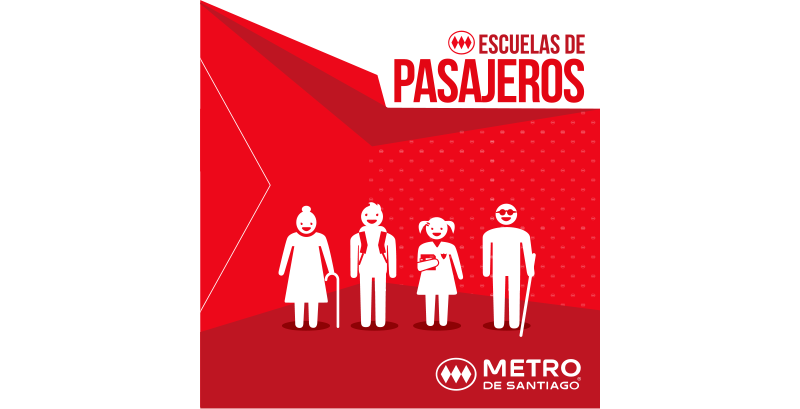
The following 16 activities were conducted during the June-November 2014 period.

Operational Improvements
During the reporting period, the following improvements were made to Metro’s network currently in operation:
Train Upgrades: AC systems were installed on Line 1 trains starting in 2013. There were 14 new trains added to the ranks and another 12 trains were modified by the end of 2014. By now, 60% of the Line 1 rolling stock is equipped with AC. By the end of 2015 it is expected that 100% of the trains will be refurbished. At a later stage, close to 60% of the trains on Lines 2 and 5 will also be fitted with AC systems.
Retrofitting of NS74 trains: detail engineering work began in order to retrofit NS74 trains, plus the construction of a manufacturing facility at Taller Neptuno, in order to extend the life of this train model by 20 years.
Implementation of Automated Control System for trains: in addition to other perks, the system will entail benefits related to transportation supply and consumption.
Enabling Web pay to load Bip! Card: implementation of bip! Card loading from a checking account or sight account 24/7, followed by validate of the credit at an Infobip center or kiosk at our network stations. Additionally, 800 new loading posts were added to the loading network, in addition to retail stores, schools and shops.
Customer Satisfaction
[G4-PR5] A third-party pollster firm interviews customers at our stations on a monthly basis asking them questions about relevant aspects of our service. Individuals chosen to take part in the surveys are selected from among users at all network sites, i.e., lines, and stations, and at different times. Results are shared with and reviewed by each line subdepartments, in addition to operations, marketing, maintenance, human resources, among others, in order to implement work programs that provide continuous improvements to our management.
In 2014 user satisfaction underwent ups and downs, with the month of September ranked the worst at 38% net satisfaction. This poor score is attributed to major service interruptions affecting operations and customer travel.
However, poll results showed that implementing the Service Pillars did have a positive impact. This is evidenced by comparing the annual average satisfaction rate of “kindness of the service personnel” ranked at 45% in 2013 with the 2014 rate at 56%, as well as the “level of satisfaction with professionalism” rate situated at 50% in 2013 compared to 60% the following year.
These are remarkable results bearing in mind that Metro faced major operational failures in late 2014, which has a potential negative impact on passengers’ perception of this aspect.
One negative result was the drop in passenger satisfaction with our riding conditions, which was previously one of the most highly appreciated attributes. This average annual rate fell from 49% in 2013 to 43% in 2014. This attribute is influenced by our passengers’ perception in rush hour, which is why we are constantly implementing action plans to meet customer demands. Last year, however, the operational issues experienced by our service, which increased passengers’ perceived discomfort during their commute, compounded the situation.
Managing Contingencies
As stated above, there were some substantial incidents that took place in August and November 2014. These has a significant impact on Metro’s operation and made it necessary to conduct evacuations and reinforce surface bus services. Following these operational failures, Metro set out to implement a new management approach aimed at mitigating the impact of service interruptions on our customers and the city. The High Impact Failure Management Plan takes into account internal analyses, suggestions by an Expert Committee, our workers’ opinion and best international practices. By means of short and long-term actions in Metro’s maintenance, operations and communications areas, the company intends to cut the failure rate and service restoration time when this kind of event happens.
The plan entails a US$114-millon investment, annual expenditures of US$14 million and the following actions:
Maintenance:
- Checking and replacing the 750 Vcc insulators at critical points along the network.
- Enhanced presence of our maintenance teams throughout the network at rush hour.
- Checking on the trains’ backup power supply systems.
- Thoroughly inspecting tracks components.
- Hiring the first team to reinforce technical review of contracts and expedite standardization.
- Reinforcing the comprehensive cleaning of facilities and technical equipment, as well as checking tracks, manholes and gutters.
On top of these actions Metro has implemented strategic and organizational management measures, such as process improvement on maintenance planning, enhancing the sourcing process, modernizing the maintenance management support system, redefining the role of maintenance in operations management, reinforcing technical maintenance inspections, and reviewing and reinforcing the organizational structure of maintenance.
Operations-wise the emphasis has been made on optimizing coordination with street level public transportation, and setting up previously-agreed action plans to address contingencies. More information about work developed by Metro and other relevant stakeholders is available in Chapter on Urban Setting.
In order to better manage emergency situations, Metro has implemented the following actions:
- Increasing headcount at stations.
- Building the job retraining team for staff working in traffic, stations, intermodal stations and Integrated Control Center.
- Reviewing the Station, Trains, Tunnels and Tracks Emergency Manual.
- Reviewing the Tunnel Evacuation Protocol.
- Providing stations with equipment to ensure communication and facilitate the re-directing of passengers during emergencies.
Communicating with Customers
[G4-PR3] The Riding Experience and Passenger Communication area is responsible for defining passenger communications. Information is produced by the Communications Center (CC) located at the Integrated Control Center (ICC). The purpose of this communication is to keep passengers informed during the entire riding experience and provide useful, clear and timely information.
Passenger communication covers four aspects, each with its own specific objectives:
- Regular information: information about the network’s operation status and riding times posted on several channels such as Twitter, mobile applications, web page, station access screens, traffic light stands and displays over platforms.
- Education: activities carried out during “Passenger Academies” and campaigns on best practices regarding the use of this means of transportation.
- Link Information: campaigns on special dates such as New Year’s, Mother’s Day, Independence Day, among others, in order to establish links between the company and passengers.
- Information during breakdowns: information during and after emergencies.
Metro has passenger evacuation procedures that apply to their trains, tunnels and stations during service disruptions. During the service breakdown on August 20, 2014, fifty thousand people were evacuated from the network without any major incident. However, the company realized it was necessary to improve information provided to passengers once they were already outside at the street level. After having learned this lesson, Metro set up a team to review and reinforce passenger information protocols during emergency situations. Actions adopted include:
Communication plans: Communication plans were drawn up for specific service disruptions, specifying what to say, when to say it and which channels should be used to convey the message, depending on the nature and scope of the contingency. The purpose of all of this is to keep our passengers informed during their riding experience. These plans are applicable to all customer-related media communications, one of which corresponds to communication from our train operators to passengers. To that end, a passenger communications sheet was designed for our train operators, with a view to facilitating and standardizing messages delivered by our train operators.
Access displays: these were first implemented at 44 access points to 18 stations throughout our network. The purpose is to provide service information to passengers when they access the network, all the more important during contingencies affecting the regular timing of our services.
Due to their location these displays are very beneficial to our passengers. They provide them with information on how to best continue their commute even before they enter the station. They also help prevent commuters from going up and down stairs in the wrong direction simply because they are already know what is going on inside the station prior to entering and they do not need to head back from inside, thereby reducing the likelihood of accidents. These displays are also useful in that they limit crowding at station entrances because riders can see the stations are full from a comfortable distance.
The second stage of this initiative will be implemented at another 48 stations in 2015, increasing our coverage to 80% of passenger traffic in one year.
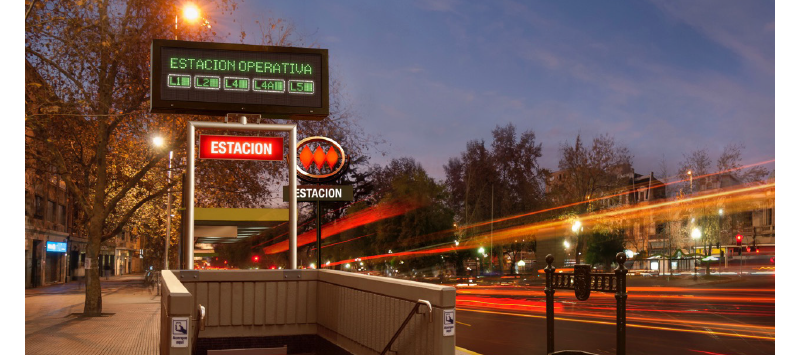
Helpful Information to Continue your Commute: new solutions are being implemented to provide Metro commuters with bus service information in order to facilitate connections to street-level bus service when Metro operations are disrupted. Information includes location of nearby bus stops and bus line services available. More information on this communication initiative is available in the chapter on Urban Setting.
Emergency information: the company has attributed greater importance to what information is provided to commuters during emergencies. As a result our passengers are better informed at to what steps should be taken during these situations. New visual aids were set up on all on-board displays and at the InfoMetro point at stations. The company also launched a campaign consisting of delivery of information guidelines and video clips on platform displays, social media and its Web page.
[G4-PR4] As for regulatory compliance with service information delivery requirements, Metro complies with all applicable regulations, and there weren’t any cases of Metro not complying with information delivery requirements in 2014.
[G4-PR7] Metro campaigns also meet the advertising-related criteria set forth under the Code of Ethics issued by the Commercial and Corporate Affairs Department. Likewise, by being a member of the National Advertisers Association (ANDA) Metro abides by the Chilean Code of Ethics on Advertising. Finally, additional criteria apply to advertisers companies displaying advertising in space sold by Metro through its operator.

SAFETY
[G4-PR1] By means of the Integrated Safety System called METROSAFETY we have worked on implementing our Safe Customer Program, which consists of a number of customer accident prevention actions and activities aimed at achieving zero harm.
The program consists primarily of the following action items:
- Following up on the customer accident rate.
- Putting together multidisciplinary work teams.
- Identifying critical spots with the highest number of accidents and analyzing the causes.
- Defining safety standards.
- Training operations team at the 12 most critical stations, focusing on Platform Assistants and Customer Assistants.
- Improving the conditions of walkways, handrails, central lighting, dangerous areas, uneven surfaces, etc.
- Organizing campaigns to correct customer misbehavior and delivering messages through loudspeakers at stations and on trains.
- Educating and training customers who are more accident prone
The CEO reports monthly to the Safety Committee on the customer accident rate.
Metro’s 2014 accident rate was 6.97 accidents per million passengers and has dropped consistently over the last few years
SHOW GRAPH
With a view to preventing accidents and encouraging our passengers to be more careful and aware during their commute, Metro and Mutual de Seguridad launched a campaign called “Escucha tu lado bueno” (listen to your good side)
Moreover, as far as crime is concerned, Metro is the safest public space in the entire capital city, with a crime rate of 0.41 crimes committed per million passengers transported in 2014—6.4% less than 2013.
In spite of all the measures adopted in our network, an unfortunate incident took place in July 2014 at the Los Dominicos station when a security guard found an explosive device. He followed company safety procedures and successfully kept the public out of harm’s way. Another serious incident took place in September, which, although it did not exactly happen in our network, it must be included in this Report. A handmade bomb was detonated in the Subcentro shopping center, located at Escuela Militar station.
Following these events Metro adopted a number of measures to reinforce network security and safety. Our company hired a British safety expert with 10 years experience in the London subway. He visited our facilities and interviewed more than 40 workers at different levels and checked a number of emergency procedures in place. Based on the conclusions of said assessment, Metro added some continuous improvement measures to its safety system, including but not limited to the following:
- Better coordination with police services and the Ministry of the Interior and the daily presence of 450 carabineros (police officers) throughout the network.
- Daily checks of stations, terminals, workshops, and all trains in circulation.
- Removal of trash bins on platforms.
- Replacement of metal trash bins with transparent plastic bags.
- New SMS 1411 service to receive user reports on events that may affect passenger safety during the commute.
- More private security guards and installation of surveillance watch towers at stations with the highest demand.
Before the safety incidents occurred in 2014, Metro was already discussing the possibility of opening a police precinct with Carabineros de Chile inside our network. Construction will begin in 2015 at the Baquedano station.

ACCESS
The Universal Access Program is designed to ensure that all individuals with limited mobility have safe and convenient access to Metro’s network and may move around as independently as possible. Metro is committed to complying with Act 20.422 in 2018.
An Access Group that keeps track of progress on a monthly basis monitors the Program.
Some milestones in 2014 were the opening of elevators at seven stations along Line 1 (Manuel Montt, Salvador, Universidad Católica, Las Rejas) and Line 2 (Rondizzoni, San Miguel and Ciudad del Niño). The engineering work will be completed in 2015 for the other seven stations included in the second phase, namely, Toesca, La Moneda, República, Neptuno, Parque O’Higgins, El Llano and Lo Ovalle.
Additionally, this year the company began a pilot project consisting of a Audible Information System (NFC Technology) at the Santa Lucia station. The system provides more autonomy and better access to the visually impaired. Users can place their mobile phones up to the acrylic boards strategically located inside the station and receive an audible message guiding them from the entrance down to the platform level, thereby allowing them to move around more independently. In the future nine other stations will be equipped with the same technology as part of this initiative, i.e.: El Parrón, Las Rejas, Los Héroes, Pedro de Valdivia, Plaza de Armas, Plaza de Maipú, Plaza de Puente Alto, Salvador, and Simón Bolívar.

ENVIRONMENTAL MANAGEMENT
Metro is essentially an environmentally-friendly transit system that requires a significant quantity of electric power for its operations. As the backbone of the Santiago public transit, Metro is responsible for millions of train rides every day, which do not release gases or particulate matter directly into the environment, and, as such, represent a veritable contribution to de-polluting the city of Santiago.
The company is also concerned with being more energy efficient and the efficient use of its resources. This is Metro’s way of controlling its greenhouse gas emissions and assuming responsibility for its repercussions on climate change. By choosing Metro as a means of transportation, users are also reduce their own emissions.
Even though Metro’s environmental impact is low, the company is still responsible for addressing it and has implemented appropriate mitigation methods. All of this is reflected under its Sustainability Policy which establishes that the company must take “better care of the environment, while fully complying with regulations, fostering best practices, managing and using our resources and energy in all areas responsibly and efficiently.”
The Public Affairs and Environment Division of the Commercial and Corporate Affairs Department is responsible for managing all processes and activities related to this matter. A multidisciplinary team of professionals and experts in environmental engineering working on different areas of the company, such as operations, maintenance and engineering staffs this division. As for the construction work on the new lines, the company also has a number of full-time professionals working directly with the Project Development Department, and their mission is to comply with environmental regulations during the construction stage.
In order to deliver on our commitment set forth under our Sustainability Policy, the company focuses its work on five different areas:

The main challenges faced by the Company in this regard in 2014 were:
- Introducing environmental criteria at the beginning of critical processes.
- Executing projects in the Environmental Mitigation Program.
- Consolidating environmental indicators for reporting.
- Metro’s carbon footprint preparation and reportability.
- Environmental Management of new line construction work.
The following section contains information on 2014 achievements and work carried out.

MITIGATING ENVIRONMENTAL IMPACTS
Mitigating Operational Environmental Impacts
[G4-EN27, G4-EN33] As a means to transportation, Metro’s contribution to making Santiago a less polluted city is well-known. However, like any other activity, environmental impacts arise mainly from the work conducted at its maintenance facilities, such as, noise pollution, vibration and waste generation.
As part of its pledge to reduce these impacts, in 2014 Metro continued implementing its Environmental Mitigation Program, which consists of ten projects related to noise and vibration, solid and liquid waste, and hazardous chemicals, all of which are at a different stage of implementation.
Progress went according to plan for the period. The following actions are worth noting: progress on the preliminary engineering designs aimed at reducing noise and vibration levels at our workshops; implementation of noise control measures in power units; and an assessment of solid and liquid waste and hazardous chemicals.
Noise and Vibration
Phase I of the “Substation Soundproofing Project” was completed. This entailed installing acoustic insulation in ventilation shafts at four network substations, thereby complying with current noise regulations enforced by the Ministry of the Environment. Phase II of the project will be implemented at four more substations during the 2015-2016 period.
Additionally, as far as noise is concerned, an acoustic insulation solution was devised for the viaduct section along Line 5 in the Maipú district.
[G4-EN29] Despite Metro’s efforts to mitigate impacts around its operations, in 2014 the company was fined up to $48,208,968 by the Environmental Protection Authority for exceeding noise limits at one of our train depots, in addition to a $126,300 fine imposed by the Municipality for disturbing noise at one electric substation.
Waste
As for waste generation, in 2014 Metro began taking stock of infrastructure management as it relates to non-hazardous industrial waste handling, with a view to mitigating waste impact while ensuring wastes are disposed of properly.
[G4-EN23] In 2014, Metro’s operations generated 2,400 tons of waste broken down as follows: 88% corresponded to domestic waste from stations and workshops, 7% to industrial waste (tires), and 5% to hazardous industrial waste.
All waste produced by Metro operations and its construction sites is stored, transported, treated and disposed of in accordance with existing regulations. Depending on the waste type, certified third-party companies are in charge of final disposal at sanitary landfills, recycling and incineration, among others.
Waste Produced by Metro Operations (kg)

Metro is continuously looking for ways to reduce the amount of waste sent to final disposal. As a result, inert waste generated at the construction sites of the new lines, mainly earth works material removed from the excavations, is entirely reused to level the height of terrain elevations, thereby extending the life of such sites.
Waste Produced during Construction of New Lines 3 and 6
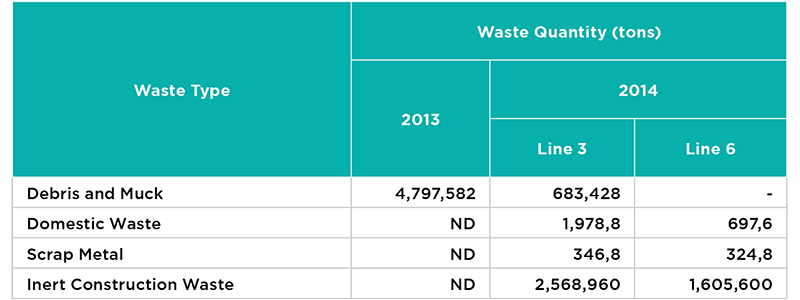
[G4-EN25] In 2014 we continued working on our “Scheduled Decommissioning of PCB Transformers” project, in order to comply with the Stockholm Convention. Four tons of PCB loaded transformers were decommissioned in 2014 and shipped to France for final incineration.
Environmental Investments
[G4-EN31] Environmental mitigation requires a significant investment. Accordingly, Metro’s pledge to reduce the environmental impact of its operations is evidenced by its investment in environmental mitigation projects, which doubled from 2013 to 2014.
Environmental Expenses and Investment for Operations
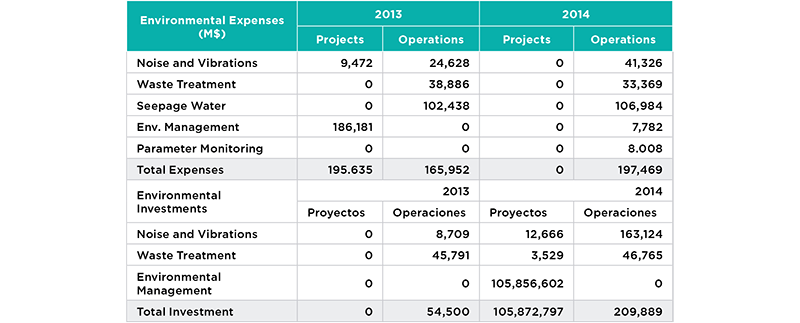
Mitigation of Environmental Impact of Lines 3 and 6
Metro understands that introducing environmental criteria as early as the project design phase helps to minimize environmental risks and their negative impact on surroundings. That is why various professional views are taken into consideration during design and construction phases of new lines, workshops and lines currently in operation.
With regards to the new Line 3 and 6 project, Metro has met all environmental regulatory requirements and adopted necessary mitigation measures to ensure that the expansion process is as least invasive as possible on both the city and neighboring communities. In 2014, mitigation measures to deal with environmental impacts resulting from early construction works were taken on all fronts, i.e.: shaft sinking, station, workshop and train depot construction. Some of the measures adopted are as follows:
- Noise: noise is mitigated through physical barriers located at all construction sites, training workers, posting signs and scheduling the noisiest jobs for daytime hours.
- Muck disposal: since we are dealing with underground construction works, a great deal of muck is generated. Much is hauled out on covered trucks to disposal locations approved by authorities.
[G4-EN29] Despite the above measures taken by Metro in 2014, the company was fined by the municipality for disturbing noises coming from a shaft construction site and for obstructing rainfall runoff with debris placement.
As for citizens participating in processes related to the Environmental Impact Assessment System, Metro filed four Environmental Impact Statements (DIAs) in 2014, two for each new line. Metro withdrew one of these declarations as a result of changes to the construction process, and eliminated one new working front. The company plans on completing these processes in 2015 upon publishing the corresponding Environmental Qualification Resolutions.
[G4-EN34] During the citizens’ participation process in 2014 a group of neighbors living near Line 3 filed two claims with the Executive Management of SEA (Environmental Assessment Bureau). These were addressed at a single administrative procedure conducted that same year instead of taking administrative action.

ENERGY
Energy Consumption
[G4-EN3] Metro considers energy consumption to be a strategic concern. Accordingly, as outlined under the company’s strategic objectives and its Sustainability Policy, it has pledged to foster the efficient use of energy resources.
Its primary source of electric power consumption are train traction mechanisms, which account for 82% of the company’s total energy consumption of 1,478,496 GJ. The 18% remaining is used for lighting.
SHOW GRAPH
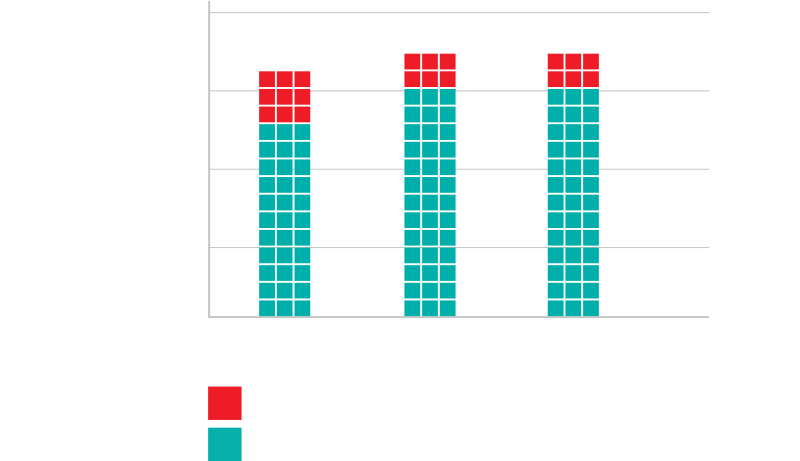
For ten years prior to March 10, 2014, Metro held a contract with Chilectra for electric power supply at a constant price and indexed to the node price. In 2012, the company began two tendering processes and one direct negotiation in order to secure long-term stable supply. Neither of these processes panned out for a number of reasons.
In view of this context, Metro’s Board of Directors crafted a strategy to secure its medium-term power supply by buying energy at the marginal price, which explains why a private negotiation was undertaken. In March 2014, the Company signed an Electric Power Supply Agreement with Enorchile S.A., effective as of April 1, 2014, securing supply from the current grid for a three-year period (until March 31, 2017).
Although this agreement secures the company’s power supply, it does not minimize the risks associated with spot price variability. As a result, in 2014 the company began negotiating directly with several potential suppliers in order to guarantee its long-term power supply at stable prices.
In addition to electric power, Metro uses other fuels to operate the machinery running on its tracks, maintain its equipment, fuel taxis employed for personnel transportation, its backup power generators, and heating its facilities and cafeterias. Gasoline, diesel and LPG consumption decreased slightly from 2013 to 2014.
SHOW GRAPH
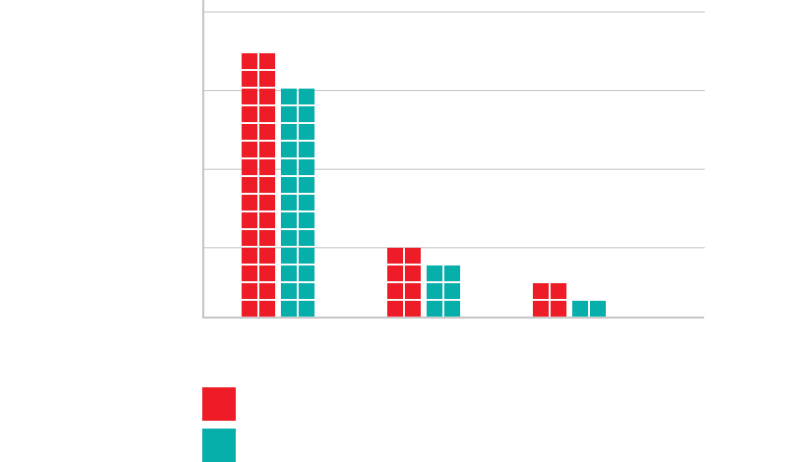
As for power used during construction of new lines, 100% comes from diesel, amounting to a grand total of 10,604,587 liters in 2014.
2014 Diesel Consumption at Construction Sites (L)
SHOW GRAPH

Energy Efficiency
[G4-EN6] Metro has an Energy Efficiency Program focused on gradually reducing energy consumption on its own network in order to reach a 10% reduction by 2018, using 2013 as the base scenario and counting all lines currently in operation (2014).
One of the most significant challenges taken on under the Program consists of encouraging and supporting energy efficiency initiatives. The Systems and Infrastructure Engineering Division of the Engineering and Technology Department is in charge of developing those initiatives, which have resulted in remarkable savings over the last few years.
In 2014 the company outlined a very ambitious plan for the next few years, intended to greatly improve our energy performance by using more efficient technologies, adopting best practices and creating an energy savings culture.
Last year the company embarked upon a lighting renewal project at the 18 oldest stations along Line 1. This entailed replacing current light fixtures with more efficient and technologically-improved solutions, thereby enhancing the safety and quality of services provided to our users, not to mention considerably reducing electric power consumption at stations and replacing obsolete equipment.
Moreover, an engineering firm was hired to manage the lighting upgrade of another 18 stations along Lines 2 and 5, marking the beginning of a new effort to promote a culture of energy efficiency and savings among our workers. A new, ISO 50,001certified energy management system was set up at the Puente Cal y Canto and Pedro de Valdivia stations.
Existing efficiency initiatives such as loop systems, regenerative braking energy, use of software-based electric power management and the implementation of smart lighting systems all contributed to a total savings of 79.8 GWh of electricity during 2014.
Energy Efficiency Initiatives & Energy Consumption Reductions
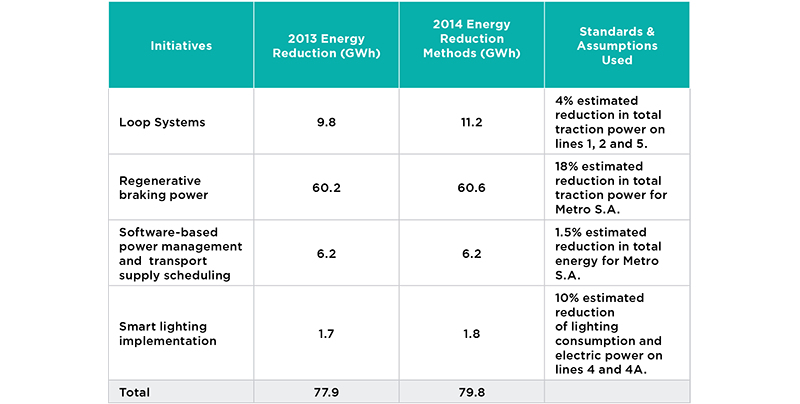
[G4-EN5] One method employed to analyze energy consumption efficiency involves determining the consumption intensity of a specific measure within the organization. At metro we measure the consumption intensity of traction energy per car/kilometer and energy used to light each m2 of facilities.
Energy Intensity of the Operations
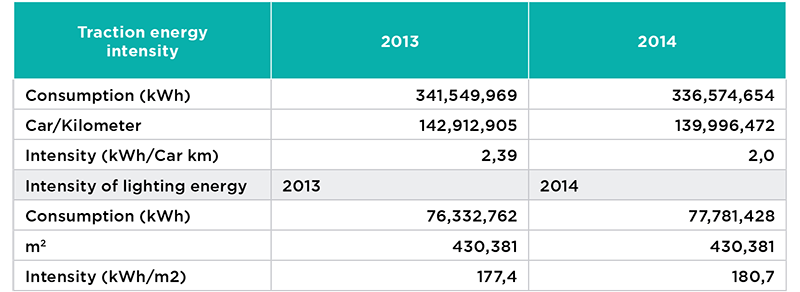

AIR EMISSIONS
Carbon Footprint
[G4-EN15, G4-EN16 Y G4-EN17, G4-EN19] In 2011 Metro began measuring its operations-related carbon footprint. This process entails identifying all activities or areas within the company that have a higher impact in terms of carbon dioxide equivalent emissions (CO2-e). The marks the company’s first step towards developing an effective emissions reduction plan.
It is worth noting that every year new variables are added to the equation for determining the company’s carbon footprint is concerned, making it unfeasible to compare data from one year to the next.
Metro’s main source of operations-related Greenhouse Gas Emissions (GHG) is electric power consumption (Scope 2). As a result, 91.64% of the company’s total footprint is due to electric power consumption, whereas the remaining 0.2% is due to fuel consumption (Scope 1), and 8.35% is attributed to direct emissions related to Scope 3. Scope 3 direct emissions are connected to drinking water production, sewage water treatment, production of consumables, cargo and employee transportation, business trips, and waste treatment.
SHOW GRAPH

Carbon Footprint of Metro Operations
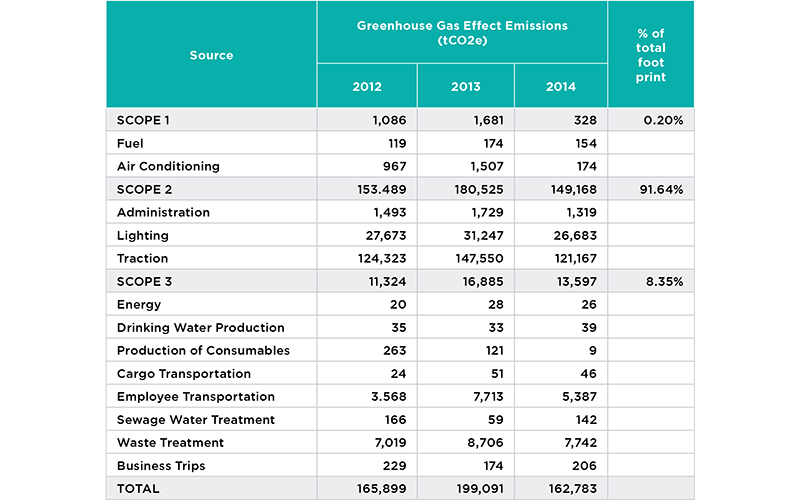
NOTE: Metro’s carbon footprint reduction from 2013 to 2014 is explained by an adjustment in the emission factor of the Central Power Grid (Sistema Interconectado Central) by the Ministry of Energy (http:// huelladecarbono.minenergia.cl/ factores-de-emision). Additionally, footprint calculations for 2014 are based on actual data, whereas in 2013 much of data were estimates.
In 2014, for the first time ever the company calculated the carbon footprint associated with construction work on the future Lines 3 and 6. Since construction work was contracted out and is not directly under Metro’s supervision, the company only measured Scope 3 of the footprint, leaving out Scopes 1 or 2. The company’s carbon footprint is mainly related to the use of consumables for construction works, amounting to a total of 838,012 tons of CO2-e.
Carbon Footprint from Construction Work on Lines 3 and 6

[G4-EN18] Bearing in mind that Metro continues to expand its operations by building new lines, the best way to conduct a year-to-year comparison of the carbon footprint is by calculating the intensity of GHG emissions under Scopes 1 and 2. In 2014 said intensity was 0.00107 tCO2-e/Car Km, compared to 0.00128 tCO2-e/Car Km in 2013.
Other Air Emissions
[G4-EN21] Underground transit systems have a positive environmental impact since their operations help reduce emissions and pollution in the city. However, construction works undertaken during expansion and construction stages do generate air emissions, which is why it is important to report emissions contributed by Line 3 and 6 construction work.
Major Air Emissions related to Construction Work on Lines 3 and 6 in 2014

* Emissions are estimated using the January 2012 Guide to Estimating Air Emissions for Real-Estate Projects for the Metropolitan Region issued by the Regional Environment Agency. (“Guía para la Estimación de Emisiones Atmosféricas de Proyectos Inmobiliarios para la Región Metropolitana, SEREMI del Medio Ambiente, enero 2012).
[G4-EN20] Metro also measures emissions put out by ozone depleting substances, the main source of which are AC units. In 2014 there weren’t any gas refrigerants used on trains, which contributed to a significant reduction in emissions.
Consumption of Gas Refrigerants (kg)


RESPONSIBLE USE OF RESOURCES
Water Consumption
Given that we operate in the public transit industry water consumption is not a critical operational issue for our Metro lines at present. However, bearing in mind the national context and water scarcity, Metro closely monitors water consumption at all its facilities.
[G4-EN8] Ninety-eight point ninety-two percent (98.92%) of Metro’s water supply comes from water companies located in the Metropolitan Region. They source their water primarily from surface sources such as the Maipo River, La Laguna Negra, and the Yeso and Estero San Ramón reservoirs. The remainder (1.08%) comes from water wells and it is used as emergency supply. This water is used to keep enough water in the storage tank so that the pumps have enough pressure to deliver water to all the workshops, thereby preventing unforeseen shutdowns and failures.
In 2014, Metro consumed a total of 544,425m3 of water compared to 440,000m3 in 2013. Consumption at workshops accounts for 45% of total water use and it is mainly used for cleaning trains, 36% is used at the stations, 13% at intermodal terminals, and 5% in the administrative buildings.
Increased water consumption at workshops and intermodal terminals is due to restoration work, mainly at the Neptuno Workshop and the Pajaritos Intermodal terminal.
SHOW GRAPH
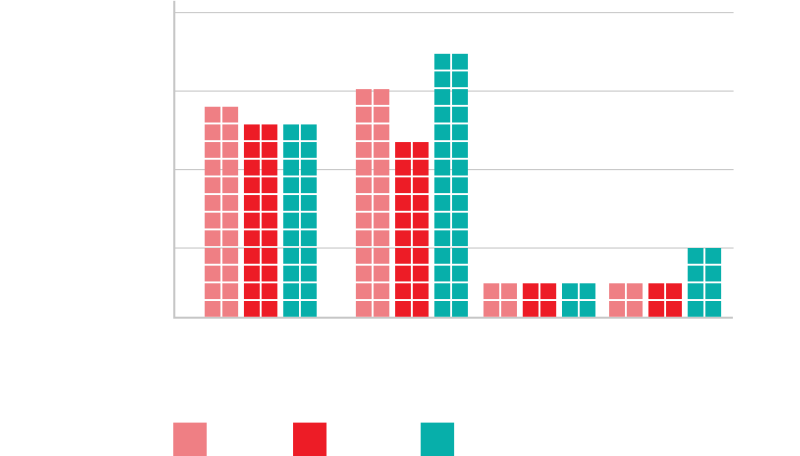
Water consumed during Line 3 and 6 construction work grew significantly from 5,738m3 in 2013 to 89,996m3 in 2014. This increase was due to the start of drilling work, earth works and removal, truck traffic and an increased headcount at each shaft. The most water-intensive process is washing truck tires at shaft entrances. This task aims to reduce dust in suspension and thereby lessen the impact of construction work on our neighbors.
[G4-EN10] Although Metro does not have a company-wide water saving and recycling practice, Taller Neptuno has its own system to recycle nearly 70% of all water used to wash trains. In 2014 approximately 315m3 of water were reused on account of this process.
[G4-EN22] All water used in company operations is disposed of through the residential sewage water system after being adequately treated, which is a responsibility of water companies.
Materials Consumption
[G4-EN1] In order to ensure Metro operates properly, the company manages and reports of use and supply of materials and consumables, especially at maintenance facilities. In 2014 Metro added new materials to its report (Acetylene, Refrigerant, Water and Paper) given the role these play in measuring the carbon footprint.
Materials Consumed during Metro Operations
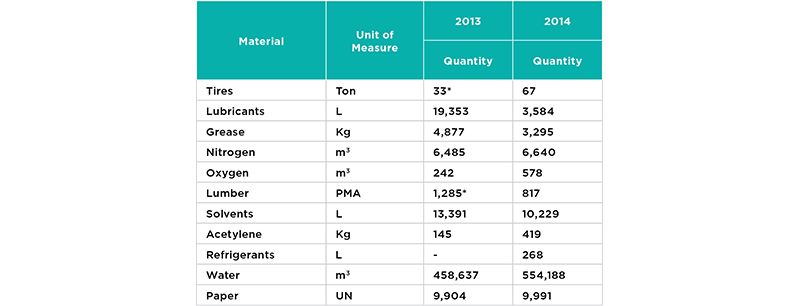
* These data differ from those in the 2013 Report due to a change in the unit of measure and in the footprint calculation.
Steel and concrete are the main materials used during Line 3 and 6 construction work.
Materials Consumed during Line 3 and 6 Construction Work

*The amount of concrete and steel used is estimated on the basis of progress made in tunnels and galleries in a year.

URBAN SETTING
[DMA] Traditionally, sustainability has encompassed economic, social and environmental dimensions. However, when defining it’s sustainability strategy back in 2012 Metro decided to add a fourth dimension, to wit, urban setting. The company’s Sustainability Policy defines Metro’s commitment to its urban setting as “making a contribution to the city’s development through our services and projects.”
Metro’s goal is to provide quality, efficient, reliable and safe services while facing the sundry challenges inherent to being a critical piece in the urban transport system. The company takes on this challenge by setting certain criteria that take into consideration the various dimensions affecting urban quality of life. Network expansion is meant to be a key piece in the urban integration puzzle. This way the company is able to meet its goal of making a positive contribution to the lives of city residents by offering them with services that give them more free time, better air quality, access to recreational areas, and other benefits.
The Urban Setting pillar of Metro’s 2014 Action Plan focuses on three areas: including sustainability criteria in long-term network expansion projects, integrating public spaces, and making the integrated system more efficient.

URBAN INTEGRATION
Metro’s role as a link between other urban means of transportation is fundamental. As a result, the company must maintain open and effective communication with its users and other agencies in charge of operating and planning the public transit system. Having the right information during unscheduled contingencies is particularly important for when Metro needs to coordinate its network operations with ground transportation. Nevertheless, our concept of integration goes beyond that and our management seeks to add value to the urban settings located within our areas of influence.
Integrated Transit System
Metro constantly works with other players involved in the public transit system. The Master Transport Plan is an excellent example of system coordination. This plan is the result of a system-wide need for guidelines on administrative matters and strategic investments in infrastructure that shape the urban transit system and that meet city residents’ long-term commuting needs. In this framework Metro sits on an integrated technical committee with the MTT, EFE, MINVU/SERVIU, MOP/Concessions, Ministry of Social Development, GORE, DIPRES, and SEGPRES.
Communication and Coordination
Metro is constantly in contact with and coordinating its activities with authorities, users and communities. Not only does this ongoing relationship make for a well-functioning system, but it also allows Metro to mitigate the negative effects of construction works and act efficiently in the event of contingencies.
A specific example of the above is how Metro handled construction work on Suecia Street where the company built the new Los Leones Line 6 terminal station. The tracks were ready for train traffic by the company-set deadline, which was in part made possible thanks to coordinated actions with the Ministry of Transportation and Telecommunications and the Municipality of Providencia.
Given the contingencies Metro faced in 2014, the company identified a significant gap in terms of information it provides its users. Evacuation procedures were followed without any incidents or accidents during these events, which is quite a feat in distressing times. However, the company must continue working with other city players in order enhance the integrated transit system’s response during similar situations.
In order to improve available information and illustrate the strong ties between Metro stations and the public ground transit system, the Board of Directors of the Metropolitan Department of Public Transport (DTPM) and Metro prepared new content to be broadcast over the screens displayed on train platforms and in mezzanines.
The following information is displayed:
- A network map of
- Bus routes and bus stops located near each Metro station.
- Map of area surrounding station .
- Map of station interior
- An explanation of what to do in the event of emergencies or incidents.
This is only one of many measures implemented by Metro as part of its efforts to provide public transit system users with better information.
Other communications-related measures set up by Metro are described in the chapter on Customers
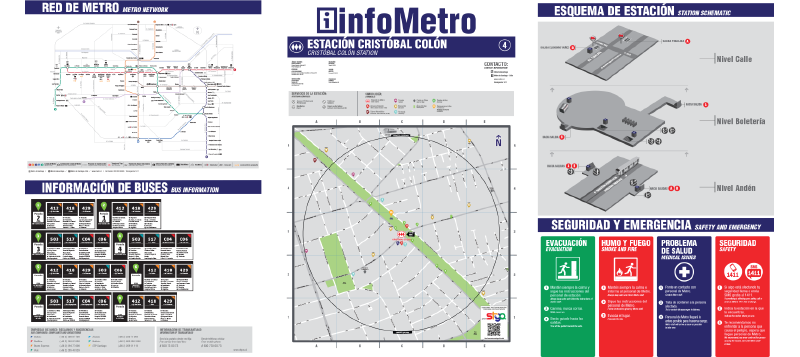
It is worth noting that the graphics displayed on Metro’s commuter information are the same as the ones used by the DTPM, thereby providing passengers with a clearer message and reaffirming the integrated nature of the public transit system.
Given the value we attribute to how much we learned regarding communications after the 2014 contingencies, Metro and other regional and local public authorities began working on a citywide coordinated response in the event of emergencies.
Strategic Alliances
Metro has entered into some strategic alliances with several organizations in order to work toward meeting sundry goals. Generally speaking these translate into working groups and committees.
- 2015 Master Transit Plan: the purpose of this is for all important players in the public transit sector to draw up a commonly-agreed to schedule to draft a plan that efficiently and equitably addresses sustainability and safety.
- Inter-sectoral Commission on Bikeable Santiago: this working group discusses various issues related to urban bike riding, such as bike paths, “Mapocho Pedaleable,” public bikes, sharing the roadways with bikes, and bike parking lots/bike racks.
- Intermodal Station Group: their work involves identifying, classifying and studying potential intermodal points; standardizing and optimizing the use of existing intermodal stations; writing up design standards and criteria; rural service fare integration, and other matters.
Metro is also involved in other specific working groups for the purpose of coordinating projects with different authorities. These groups address a variety of matters such as changes to service, making said changes public, etc.
An example of the above is the joint effort carried out by Metro and Redbus at the Zapadores/Vespucio Norte area on Line 2. This company changed their bus route for the better in order to improve the north sector’s access to Metro’s network. The public was informed of the changes resulting from this collaborative effort by way of posters placed on trains, and the outcome was more demand on both systems. The working group deemed this a success.
Integrating Public Space
Metro is constantly assessing how to make the most out of unused space that doesn’t have any commercial value. In some cases, Metro decides to lend the land to municipalities for their use. The parties sign an agreement in which local government authorities pledge to use the space wisely and to be responsible for its upkeep. These new public spaces are adapted to communities’ needs and end up adding value to urban areas. Two examples of this initiative are the concessions granted to the local Ñuñoa government to turn the Line 4 ventilation area located along Vespucio Norte into a green area and Plaza Libertad on Line 5 in the Santiago District, which was turned into a local recycling center.

NETWORK EXPANSION
Line 3 and 6 Construction
Construction of Lines 3 and 6—an approximate investment of USD2,758 million—has undoubtedly been the most ambitious undertaking in the history of the company. The projects aims to provide commuters with several benefits such as a shorter travel time, less congestion at the busiest stations, and a stronger, more robust Metro system for Santiago. Moreover, the new lines will make the city a better connected, functional and operative place, thanks to the addition of connecting stations between Metro lines and better connections with suburban rail lines. Close to one million users will reap the benefits when both lines are finally operational in 2018.
Furthermore, the project will also benefit users by creating close to 9,000 direct jobs along the entire production chain (direct labor, supplies, goods, etc.).
In 2020, once Lines 3 and 6 are operational and the other announced expansions in place, Metro’s network will consist of a total of 148.9 kilometers and 143 stations.
At present, close to 6,000 individuals and 216 contractors are working on the project and making a concrete contribution to the economy.

Metro Park Network
Individuals today attribute a great deal of importance to public, recreational and green areas, which is why Metro has decided to give the new lines’ facilities an identity—both on the outside (ground level) and on the inside (station level). The idea is to continue “making a city” by creating new and different connections in Santiago, giving the transit system and public spaces a face lift and more dignity, while bringing existing parks and squares closer to the people, which is perhaps something that wasn’t possible prior to the arrival of the new lines.
That is where we got the idea for the Metro Park Network. The goal is to build this new transportation infrastructure in such as way that Metro stations are integrated and connected to Santiago’s system of parks and squares. This will provide residents with better access to 167 parks and squares dotting the neighborhoods through which Metro lines run—an effort to give back to the people the public space that was taken away because of construction.
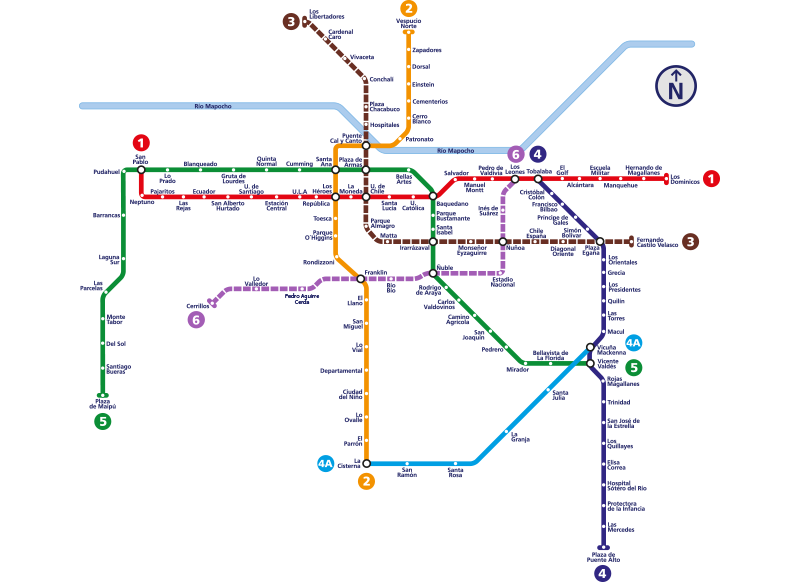
New Station Design
As far as stations located along the new lines are concerned, Metro’s design goals are to integrate the exterior with the interior, design with the times, have something functional, and create a unified Metro identity under a brand image that projects safety, efficiency, environmental respect, plurality, inclusion, amusement, and balance.
Doing a good job at creating an indoor/outdoor experience for customers is one of the project’s goals, i.e., “carrying the outside on the inside” and merging the two worlds.
Metro is also working on creative ways to connect its stations with city life, for example, letting in natural light, having a visual connection between the indoors and outdoors, and natural ventilation. This is a company-wide effort, involving all departments, from design to functionality and operations.
Archaeological Findings
Metro is fully committed to preserving and protecting Chile’s historic heritage and is bound to uphold regulations imposed by the Council of National Monuments when it stumbles upon archaeological remains during its excavations. Essentially, this involves following established procedures in order to protect all discoveries to the best extent possible.
During new line excavations, specifically the Europa, Hospital, Franklin, Plaza de Armas, and Los Leones shafts, the company came across some very important findings, and is working with the National Monuments Council to preserve the value of the findings by showcasing them at Los Leones and Franklin stations.
Line 2 and 3 Extensions
In November 2014, Chilean President Michelle Bachelet announced that Lines 3 and 2 would be extended toward Quilicura, and El Bosque and San Bernardo, respectively. All tallied, 8.9 kms. of new tracks will be laid and more than 600,000 residents will reap the benefits.
- Line 2 extension to El Bosque and San Bernardo will entail 5.1 kilometers and four stations.
- Future Line 3 extension to Quilicura will benefit close to 200,000 area residents and add 3.8 kilometers of tracks and three stations.
Expansion projects will bring a series of improvements to users including a more comfortable and shorter commute.







 ENTER
ENTER
 CONTENT
CONTENT Introduction
Introduction